ERP Implementation in SMEs
VerifiedAdded on 2020/05/16
|19
|4488
|117
AI Summary
This assignment delves into the crucial elements that contribute to successful Enterprise Resource Planning (ERP) implementations within Small and Medium-sized Enterprises (SMEs). It examines various aspects, including strategic planning, organizational readiness, technological considerations, change management, and stakeholder engagement. The provided resources offer insights into best practices, challenges, and key success factors for ERP adoption in the SME context.
Contribute Materials
Your contribution can guide someone’s learning journey. Share your
documents today.
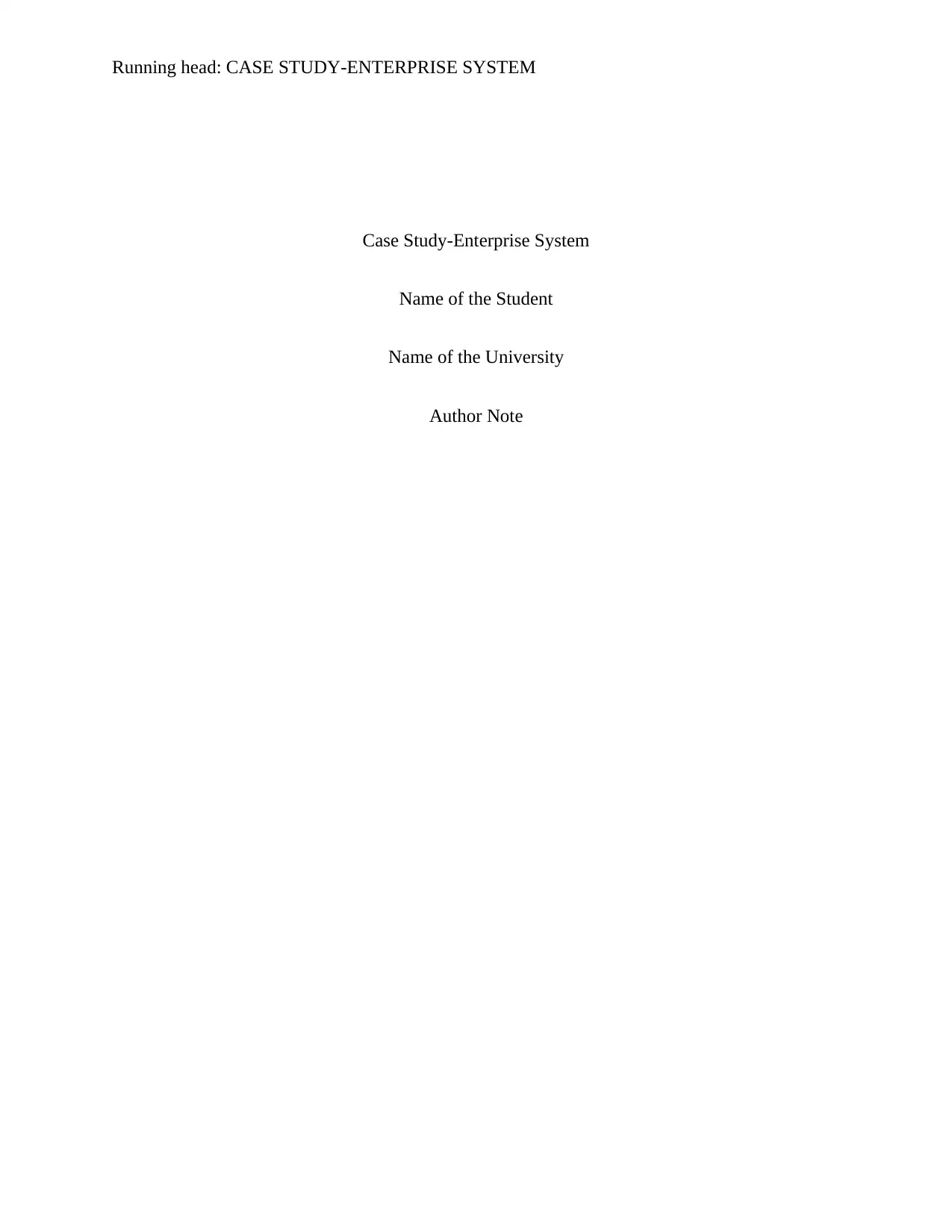
Running head: CASE STUDY-ENTERPRISE SYSTEM
Case Study-Enterprise System
Name of the Student
Name of the University
Author Note
Case Study-Enterprise System
Name of the Student
Name of the University
Author Note
Secure Best Marks with AI Grader
Need help grading? Try our AI Grader for instant feedback on your assignments.
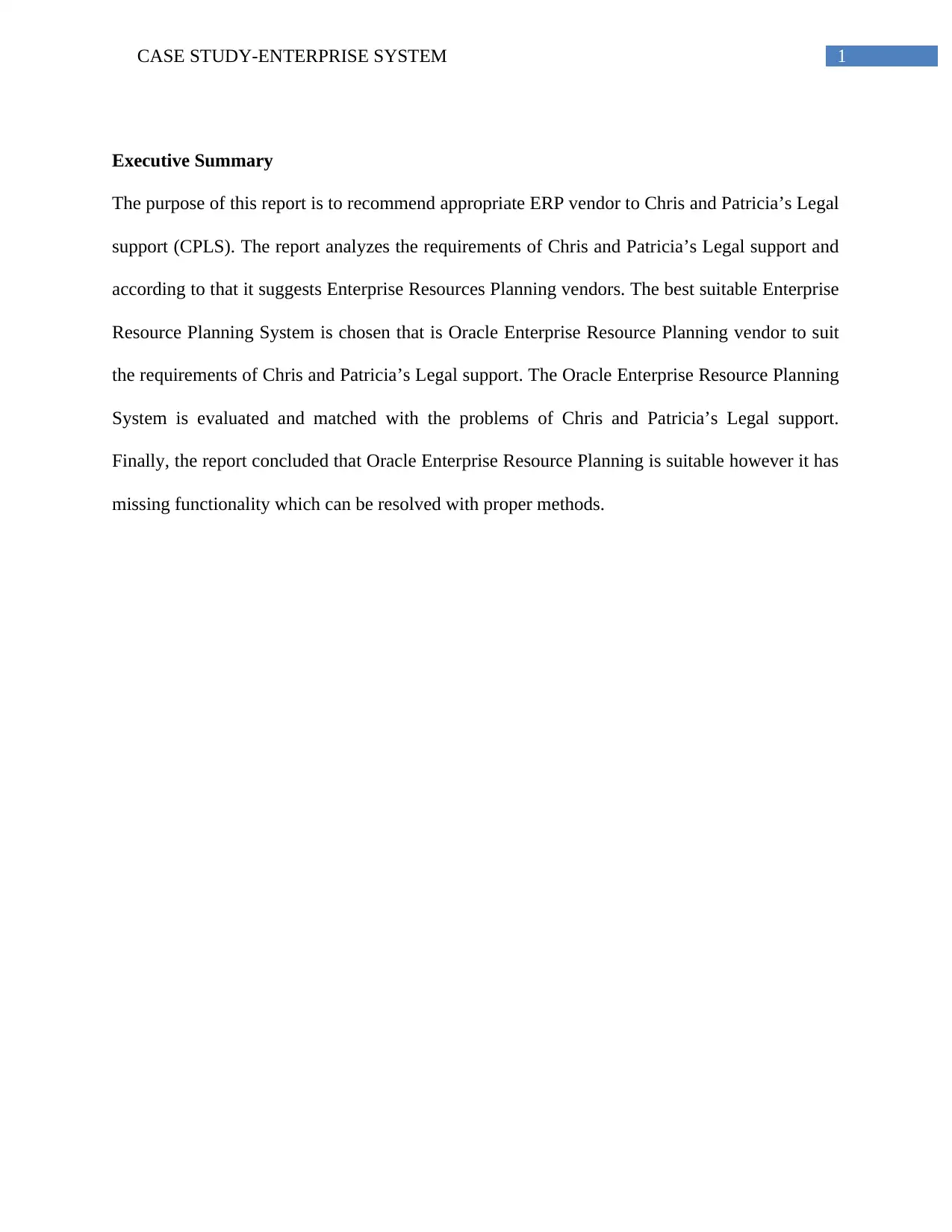
1CASE STUDY-ENTERPRISE SYSTEM
Executive Summary
The purpose of this report is to recommend appropriate ERP vendor to Chris and Patricia’s Legal
support (CPLS). The report analyzes the requirements of Chris and Patricia’s Legal support and
according to that it suggests Enterprise Resources Planning vendors. The best suitable Enterprise
Resource Planning System is chosen that is Oracle Enterprise Resource Planning vendor to suit
the requirements of Chris and Patricia’s Legal support. The Oracle Enterprise Resource Planning
System is evaluated and matched with the problems of Chris and Patricia’s Legal support.
Finally, the report concluded that Oracle Enterprise Resource Planning is suitable however it has
missing functionality which can be resolved with proper methods.
Executive Summary
The purpose of this report is to recommend appropriate ERP vendor to Chris and Patricia’s Legal
support (CPLS). The report analyzes the requirements of Chris and Patricia’s Legal support and
according to that it suggests Enterprise Resources Planning vendors. The best suitable Enterprise
Resource Planning System is chosen that is Oracle Enterprise Resource Planning vendor to suit
the requirements of Chris and Patricia’s Legal support. The Oracle Enterprise Resource Planning
System is evaluated and matched with the problems of Chris and Patricia’s Legal support.
Finally, the report concluded that Oracle Enterprise Resource Planning is suitable however it has
missing functionality which can be resolved with proper methods.
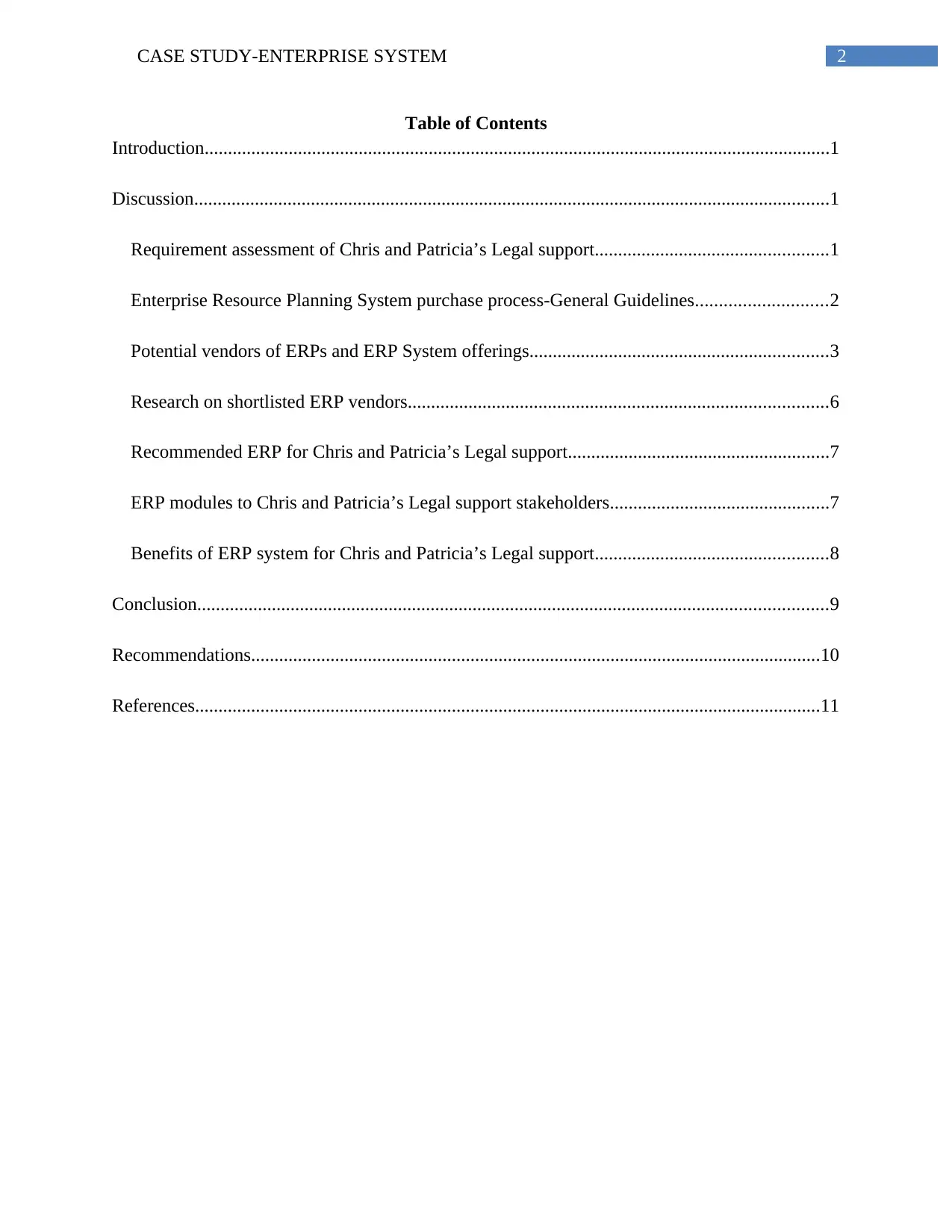
2CASE STUDY-ENTERPRISE SYSTEM
Table of Contents
Introduction......................................................................................................................................1
Discussion........................................................................................................................................1
Requirement assessment of Chris and Patricia’s Legal support..................................................1
Enterprise Resource Planning System purchase process-General Guidelines............................2
Potential vendors of ERPs and ERP System offerings................................................................3
Research on shortlisted ERP vendors..........................................................................................6
Recommended ERP for Chris and Patricia’s Legal support........................................................7
ERP modules to Chris and Patricia’s Legal support stakeholders...............................................7
Benefits of ERP system for Chris and Patricia’s Legal support..................................................8
Conclusion.......................................................................................................................................9
Recommendations..........................................................................................................................10
References......................................................................................................................................11
Table of Contents
Introduction......................................................................................................................................1
Discussion........................................................................................................................................1
Requirement assessment of Chris and Patricia’s Legal support..................................................1
Enterprise Resource Planning System purchase process-General Guidelines............................2
Potential vendors of ERPs and ERP System offerings................................................................3
Research on shortlisted ERP vendors..........................................................................................6
Recommended ERP for Chris and Patricia’s Legal support........................................................7
ERP modules to Chris and Patricia’s Legal support stakeholders...............................................7
Benefits of ERP system for Chris and Patricia’s Legal support..................................................8
Conclusion.......................................................................................................................................9
Recommendations..........................................................................................................................10
References......................................................................................................................................11
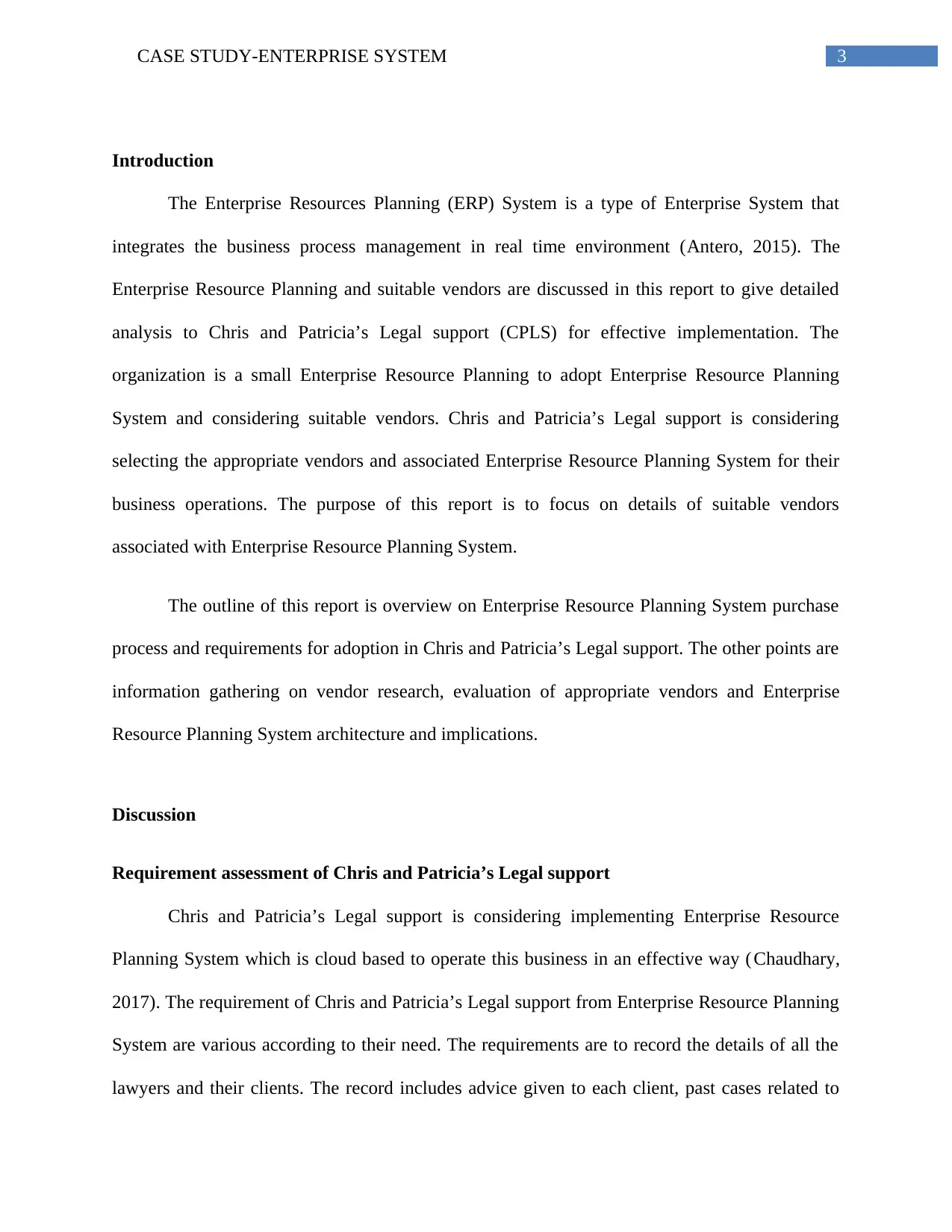
3CASE STUDY-ENTERPRISE SYSTEM
Introduction
The Enterprise Resources Planning (ERP) System is a type of Enterprise System that
integrates the business process management in real time environment (Antero, 2015). The
Enterprise Resource Planning and suitable vendors are discussed in this report to give detailed
analysis to Chris and Patricia’s Legal support (CPLS) for effective implementation. The
organization is a small Enterprise Resource Planning to adopt Enterprise Resource Planning
System and considering suitable vendors. Chris and Patricia’s Legal support is considering
selecting the appropriate vendors and associated Enterprise Resource Planning System for their
business operations. The purpose of this report is to focus on details of suitable vendors
associated with Enterprise Resource Planning System.
The outline of this report is overview on Enterprise Resource Planning System purchase
process and requirements for adoption in Chris and Patricia’s Legal support. The other points are
information gathering on vendor research, evaluation of appropriate vendors and Enterprise
Resource Planning System architecture and implications.
Discussion
Requirement assessment of Chris and Patricia’s Legal support
Chris and Patricia’s Legal support is considering implementing Enterprise Resource
Planning System which is cloud based to operate this business in an effective way ( Chaudhary,
2017). The requirement of Chris and Patricia’s Legal support from Enterprise Resource Planning
System are various according to their need. The requirements are to record the details of all the
lawyers and their clients. The record includes advice given to each client, past cases related to
Introduction
The Enterprise Resources Planning (ERP) System is a type of Enterprise System that
integrates the business process management in real time environment (Antero, 2015). The
Enterprise Resource Planning and suitable vendors are discussed in this report to give detailed
analysis to Chris and Patricia’s Legal support (CPLS) for effective implementation. The
organization is a small Enterprise Resource Planning to adopt Enterprise Resource Planning
System and considering suitable vendors. Chris and Patricia’s Legal support is considering
selecting the appropriate vendors and associated Enterprise Resource Planning System for their
business operations. The purpose of this report is to focus on details of suitable vendors
associated with Enterprise Resource Planning System.
The outline of this report is overview on Enterprise Resource Planning System purchase
process and requirements for adoption in Chris and Patricia’s Legal support. The other points are
information gathering on vendor research, evaluation of appropriate vendors and Enterprise
Resource Planning System architecture and implications.
Discussion
Requirement assessment of Chris and Patricia’s Legal support
Chris and Patricia’s Legal support is considering implementing Enterprise Resource
Planning System which is cloud based to operate this business in an effective way ( Chaudhary,
2017). The requirement of Chris and Patricia’s Legal support from Enterprise Resource Planning
System are various according to their need. The requirements are to record the details of all the
lawyers and their clients. The record includes advice given to each client, past cases related to
Secure Best Marks with AI Grader
Need help grading? Try our AI Grader for instant feedback on your assignments.
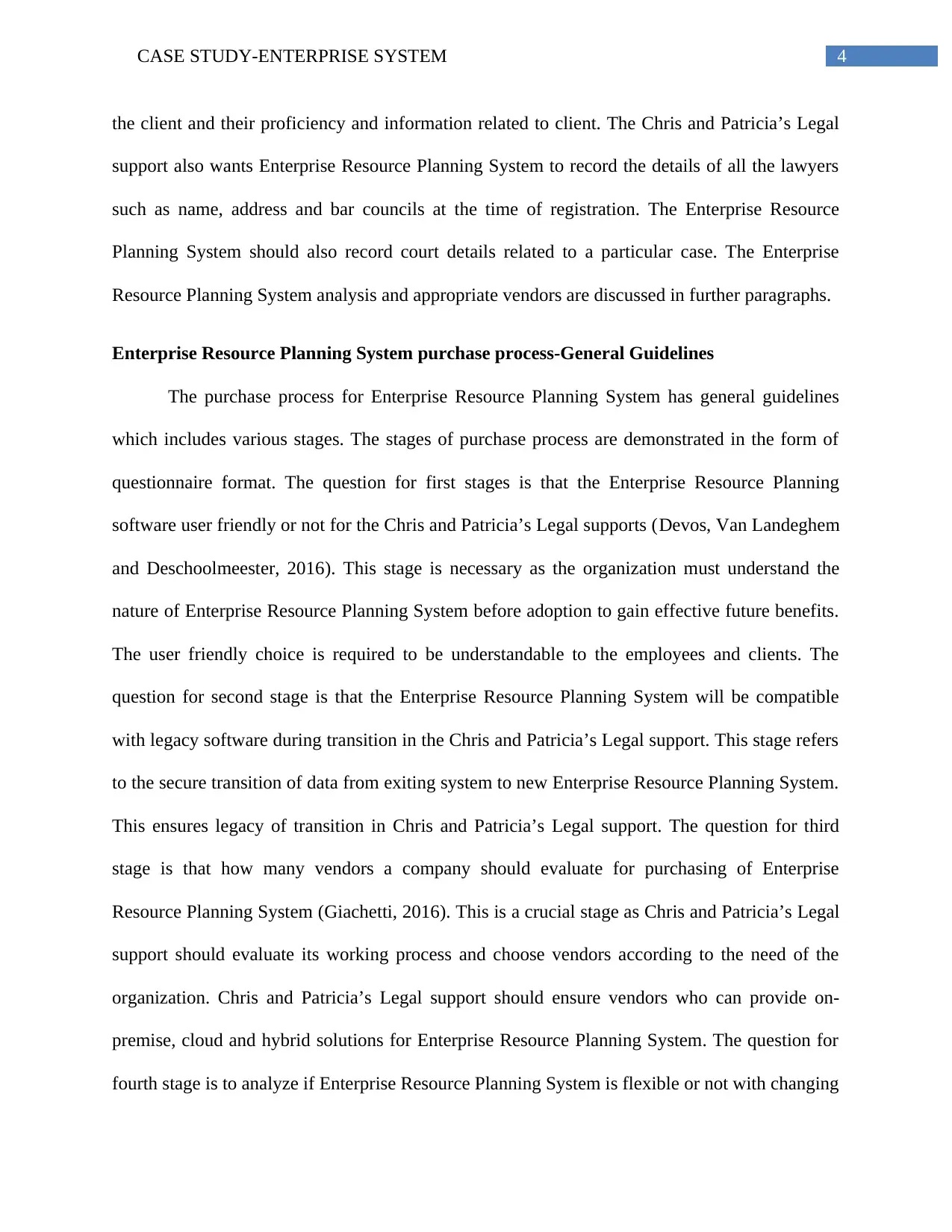
4CASE STUDY-ENTERPRISE SYSTEM
the client and their proficiency and information related to client. The Chris and Patricia’s Legal
support also wants Enterprise Resource Planning System to record the details of all the lawyers
such as name, address and bar councils at the time of registration. The Enterprise Resource
Planning System should also record court details related to a particular case. The Enterprise
Resource Planning System analysis and appropriate vendors are discussed in further paragraphs.
Enterprise Resource Planning System purchase process-General Guidelines
The purchase process for Enterprise Resource Planning System has general guidelines
which includes various stages. The stages of purchase process are demonstrated in the form of
questionnaire format. The question for first stages is that the Enterprise Resource Planning
software user friendly or not for the Chris and Patricia’s Legal supports (Devos, Van Landeghem
and Deschoolmeester, 2016). This stage is necessary as the organization must understand the
nature of Enterprise Resource Planning System before adoption to gain effective future benefits.
The user friendly choice is required to be understandable to the employees and clients. The
question for second stage is that the Enterprise Resource Planning System will be compatible
with legacy software during transition in the Chris and Patricia’s Legal support. This stage refers
to the secure transition of data from exiting system to new Enterprise Resource Planning System.
This ensures legacy of transition in Chris and Patricia’s Legal support. The question for third
stage is that how many vendors a company should evaluate for purchasing of Enterprise
Resource Planning System (Giachetti, 2016). This is a crucial stage as Chris and Patricia’s Legal
support should evaluate its working process and choose vendors according to the need of the
organization. Chris and Patricia’s Legal support should ensure vendors who can provide on-
premise, cloud and hybrid solutions for Enterprise Resource Planning System. The question for
fourth stage is to analyze if Enterprise Resource Planning System is flexible or not with changing
the client and their proficiency and information related to client. The Chris and Patricia’s Legal
support also wants Enterprise Resource Planning System to record the details of all the lawyers
such as name, address and bar councils at the time of registration. The Enterprise Resource
Planning System should also record court details related to a particular case. The Enterprise
Resource Planning System analysis and appropriate vendors are discussed in further paragraphs.
Enterprise Resource Planning System purchase process-General Guidelines
The purchase process for Enterprise Resource Planning System has general guidelines
which includes various stages. The stages of purchase process are demonstrated in the form of
questionnaire format. The question for first stages is that the Enterprise Resource Planning
software user friendly or not for the Chris and Patricia’s Legal supports (Devos, Van Landeghem
and Deschoolmeester, 2016). This stage is necessary as the organization must understand the
nature of Enterprise Resource Planning System before adoption to gain effective future benefits.
The user friendly choice is required to be understandable to the employees and clients. The
question for second stage is that the Enterprise Resource Planning System will be compatible
with legacy software during transition in the Chris and Patricia’s Legal support. This stage refers
to the secure transition of data from exiting system to new Enterprise Resource Planning System.
This ensures legacy of transition in Chris and Patricia’s Legal support. The question for third
stage is that how many vendors a company should evaluate for purchasing of Enterprise
Resource Planning System (Giachetti, 2016). This is a crucial stage as Chris and Patricia’s Legal
support should evaluate its working process and choose vendors according to the need of the
organization. Chris and Patricia’s Legal support should ensure vendors who can provide on-
premise, cloud and hybrid solutions for Enterprise Resource Planning System. The question for
fourth stage is to analyze if Enterprise Resource Planning System is flexible or not with changing
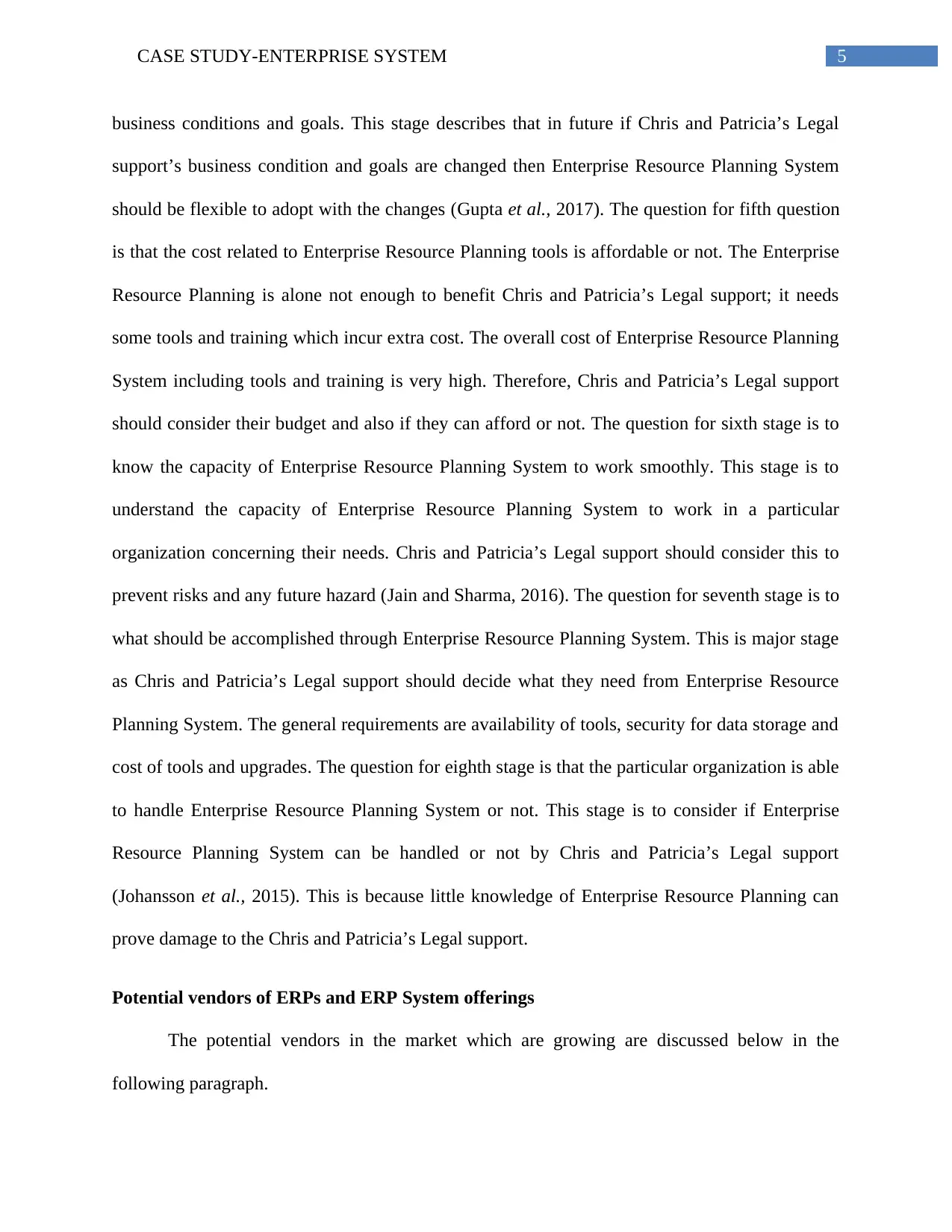
5CASE STUDY-ENTERPRISE SYSTEM
business conditions and goals. This stage describes that in future if Chris and Patricia’s Legal
support’s business condition and goals are changed then Enterprise Resource Planning System
should be flexible to adopt with the changes (Gupta et al., 2017). The question for fifth question
is that the cost related to Enterprise Resource Planning tools is affordable or not. The Enterprise
Resource Planning is alone not enough to benefit Chris and Patricia’s Legal support; it needs
some tools and training which incur extra cost. The overall cost of Enterprise Resource Planning
System including tools and training is very high. Therefore, Chris and Patricia’s Legal support
should consider their budget and also if they can afford or not. The question for sixth stage is to
know the capacity of Enterprise Resource Planning System to work smoothly. This stage is to
understand the capacity of Enterprise Resource Planning System to work in a particular
organization concerning their needs. Chris and Patricia’s Legal support should consider this to
prevent risks and any future hazard (Jain and Sharma, 2016). The question for seventh stage is to
what should be accomplished through Enterprise Resource Planning System. This is major stage
as Chris and Patricia’s Legal support should decide what they need from Enterprise Resource
Planning System. The general requirements are availability of tools, security for data storage and
cost of tools and upgrades. The question for eighth stage is that the particular organization is able
to handle Enterprise Resource Planning System or not. This stage is to consider if Enterprise
Resource Planning System can be handled or not by Chris and Patricia’s Legal support
(Johansson et al., 2015). This is because little knowledge of Enterprise Resource Planning can
prove damage to the Chris and Patricia’s Legal support.
Potential vendors of ERPs and ERP System offerings
The potential vendors in the market which are growing are discussed below in the
following paragraph.
business conditions and goals. This stage describes that in future if Chris and Patricia’s Legal
support’s business condition and goals are changed then Enterprise Resource Planning System
should be flexible to adopt with the changes (Gupta et al., 2017). The question for fifth question
is that the cost related to Enterprise Resource Planning tools is affordable or not. The Enterprise
Resource Planning is alone not enough to benefit Chris and Patricia’s Legal support; it needs
some tools and training which incur extra cost. The overall cost of Enterprise Resource Planning
System including tools and training is very high. Therefore, Chris and Patricia’s Legal support
should consider their budget and also if they can afford or not. The question for sixth stage is to
know the capacity of Enterprise Resource Planning System to work smoothly. This stage is to
understand the capacity of Enterprise Resource Planning System to work in a particular
organization concerning their needs. Chris and Patricia’s Legal support should consider this to
prevent risks and any future hazard (Jain and Sharma, 2016). The question for seventh stage is to
what should be accomplished through Enterprise Resource Planning System. This is major stage
as Chris and Patricia’s Legal support should decide what they need from Enterprise Resource
Planning System. The general requirements are availability of tools, security for data storage and
cost of tools and upgrades. The question for eighth stage is that the particular organization is able
to handle Enterprise Resource Planning System or not. This stage is to consider if Enterprise
Resource Planning System can be handled or not by Chris and Patricia’s Legal support
(Johansson et al., 2015). This is because little knowledge of Enterprise Resource Planning can
prove damage to the Chris and Patricia’s Legal support.
Potential vendors of ERPs and ERP System offerings
The potential vendors in the market which are growing are discussed below in the
following paragraph.
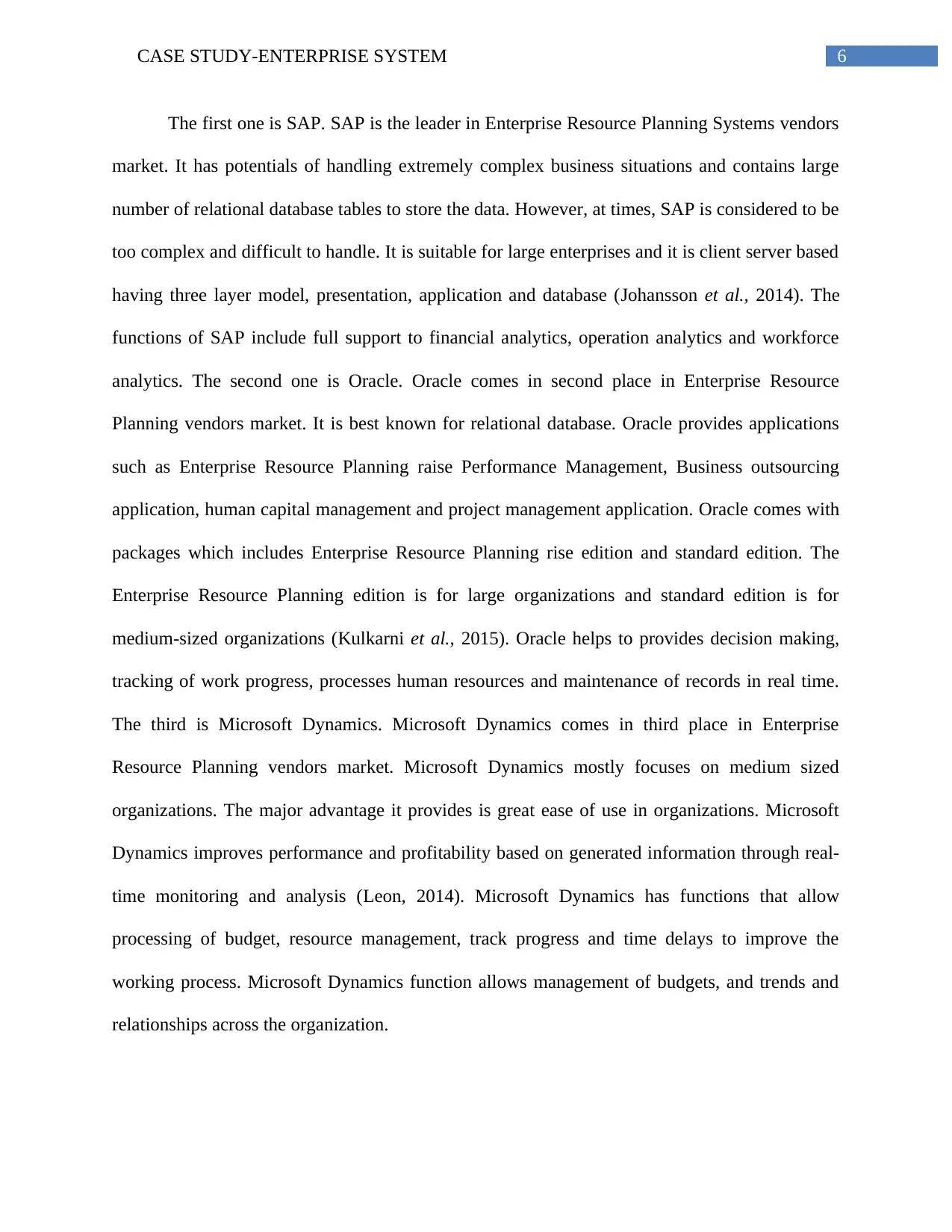
6CASE STUDY-ENTERPRISE SYSTEM
The first one is SAP. SAP is the leader in Enterprise Resource Planning Systems vendors
market. It has potentials of handling extremely complex business situations and contains large
number of relational database tables to store the data. However, at times, SAP is considered to be
too complex and difficult to handle. It is suitable for large enterprises and it is client server based
having three layer model, presentation, application and database (Johansson et al., 2014). The
functions of SAP include full support to financial analytics, operation analytics and workforce
analytics. The second one is Oracle. Oracle comes in second place in Enterprise Resource
Planning vendors market. It is best known for relational database. Oracle provides applications
such as Enterprise Resource Planning raise Performance Management, Business outsourcing
application, human capital management and project management application. Oracle comes with
packages which includes Enterprise Resource Planning rise edition and standard edition. The
Enterprise Resource Planning edition is for large organizations and standard edition is for
medium-sized organizations (Kulkarni et al., 2015). Oracle helps to provides decision making,
tracking of work progress, processes human resources and maintenance of records in real time.
The third is Microsoft Dynamics. Microsoft Dynamics comes in third place in Enterprise
Resource Planning vendors market. Microsoft Dynamics mostly focuses on medium sized
organizations. The major advantage it provides is great ease of use in organizations. Microsoft
Dynamics improves performance and profitability based on generated information through real-
time monitoring and analysis (Leon, 2014). Microsoft Dynamics has functions that allow
processing of budget, resource management, track progress and time delays to improve the
working process. Microsoft Dynamics function allows management of budgets, and trends and
relationships across the organization.
The first one is SAP. SAP is the leader in Enterprise Resource Planning Systems vendors
market. It has potentials of handling extremely complex business situations and contains large
number of relational database tables to store the data. However, at times, SAP is considered to be
too complex and difficult to handle. It is suitable for large enterprises and it is client server based
having three layer model, presentation, application and database (Johansson et al., 2014). The
functions of SAP include full support to financial analytics, operation analytics and workforce
analytics. The second one is Oracle. Oracle comes in second place in Enterprise Resource
Planning vendors market. It is best known for relational database. Oracle provides applications
such as Enterprise Resource Planning raise Performance Management, Business outsourcing
application, human capital management and project management application. Oracle comes with
packages which includes Enterprise Resource Planning rise edition and standard edition. The
Enterprise Resource Planning edition is for large organizations and standard edition is for
medium-sized organizations (Kulkarni et al., 2015). Oracle helps to provides decision making,
tracking of work progress, processes human resources and maintenance of records in real time.
The third is Microsoft Dynamics. Microsoft Dynamics comes in third place in Enterprise
Resource Planning vendors market. Microsoft Dynamics mostly focuses on medium sized
organizations. The major advantage it provides is great ease of use in organizations. Microsoft
Dynamics improves performance and profitability based on generated information through real-
time monitoring and analysis (Leon, 2014). Microsoft Dynamics has functions that allow
processing of budget, resource management, track progress and time delays to improve the
working process. Microsoft Dynamics function allows management of budgets, and trends and
relationships across the organization.
Paraphrase This Document
Need a fresh take? Get an instant paraphrase of this document with our AI Paraphraser
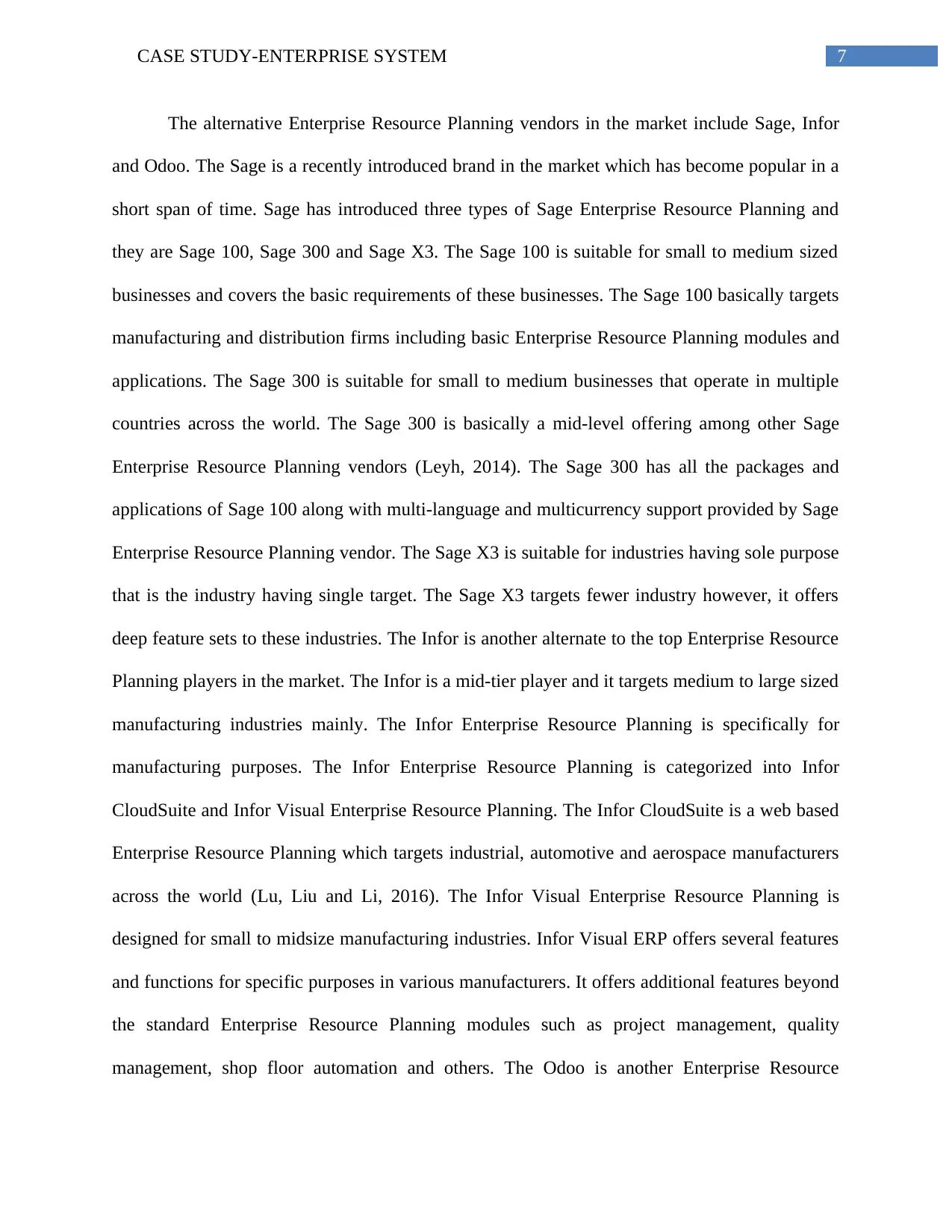
7CASE STUDY-ENTERPRISE SYSTEM
The alternative Enterprise Resource Planning vendors in the market include Sage, Infor
and Odoo. The Sage is a recently introduced brand in the market which has become popular in a
short span of time. Sage has introduced three types of Sage Enterprise Resource Planning and
they are Sage 100, Sage 300 and Sage X3. The Sage 100 is suitable for small to medium sized
businesses and covers the basic requirements of these businesses. The Sage 100 basically targets
manufacturing and distribution firms including basic Enterprise Resource Planning modules and
applications. The Sage 300 is suitable for small to medium businesses that operate in multiple
countries across the world. The Sage 300 is basically a mid-level offering among other Sage
Enterprise Resource Planning vendors (Leyh, 2014). The Sage 300 has all the packages and
applications of Sage 100 along with multi-language and multicurrency support provided by Sage
Enterprise Resource Planning vendor. The Sage X3 is suitable for industries having sole purpose
that is the industry having single target. The Sage X3 targets fewer industry however, it offers
deep feature sets to these industries. The Infor is another alternate to the top Enterprise Resource
Planning players in the market. The Infor is a mid-tier player and it targets medium to large sized
manufacturing industries mainly. The Infor Enterprise Resource Planning is specifically for
manufacturing purposes. The Infor Enterprise Resource Planning is categorized into Infor
CloudSuite and Infor Visual Enterprise Resource Planning. The Infor CloudSuite is a web based
Enterprise Resource Planning which targets industrial, automotive and aerospace manufacturers
across the world (Lu, Liu and Li, 2016). The Infor Visual Enterprise Resource Planning is
designed for small to midsize manufacturing industries. Infor Visual ERP offers several features
and functions for specific purposes in various manufacturers. It offers additional features beyond
the standard Enterprise Resource Planning modules such as project management, quality
management, shop floor automation and others. The Odoo is another Enterprise Resource
The alternative Enterprise Resource Planning vendors in the market include Sage, Infor
and Odoo. The Sage is a recently introduced brand in the market which has become popular in a
short span of time. Sage has introduced three types of Sage Enterprise Resource Planning and
they are Sage 100, Sage 300 and Sage X3. The Sage 100 is suitable for small to medium sized
businesses and covers the basic requirements of these businesses. The Sage 100 basically targets
manufacturing and distribution firms including basic Enterprise Resource Planning modules and
applications. The Sage 300 is suitable for small to medium businesses that operate in multiple
countries across the world. The Sage 300 is basically a mid-level offering among other Sage
Enterprise Resource Planning vendors (Leyh, 2014). The Sage 300 has all the packages and
applications of Sage 100 along with multi-language and multicurrency support provided by Sage
Enterprise Resource Planning vendor. The Sage X3 is suitable for industries having sole purpose
that is the industry having single target. The Sage X3 targets fewer industry however, it offers
deep feature sets to these industries. The Infor is another alternate to the top Enterprise Resource
Planning players in the market. The Infor is a mid-tier player and it targets medium to large sized
manufacturing industries mainly. The Infor Enterprise Resource Planning is specifically for
manufacturing purposes. The Infor Enterprise Resource Planning is categorized into Infor
CloudSuite and Infor Visual Enterprise Resource Planning. The Infor CloudSuite is a web based
Enterprise Resource Planning which targets industrial, automotive and aerospace manufacturers
across the world (Lu, Liu and Li, 2016). The Infor Visual Enterprise Resource Planning is
designed for small to midsize manufacturing industries. Infor Visual ERP offers several features
and functions for specific purposes in various manufacturers. It offers additional features beyond
the standard Enterprise Resource Planning modules such as project management, quality
management, shop floor automation and others. The Odoo is another Enterprise Resource
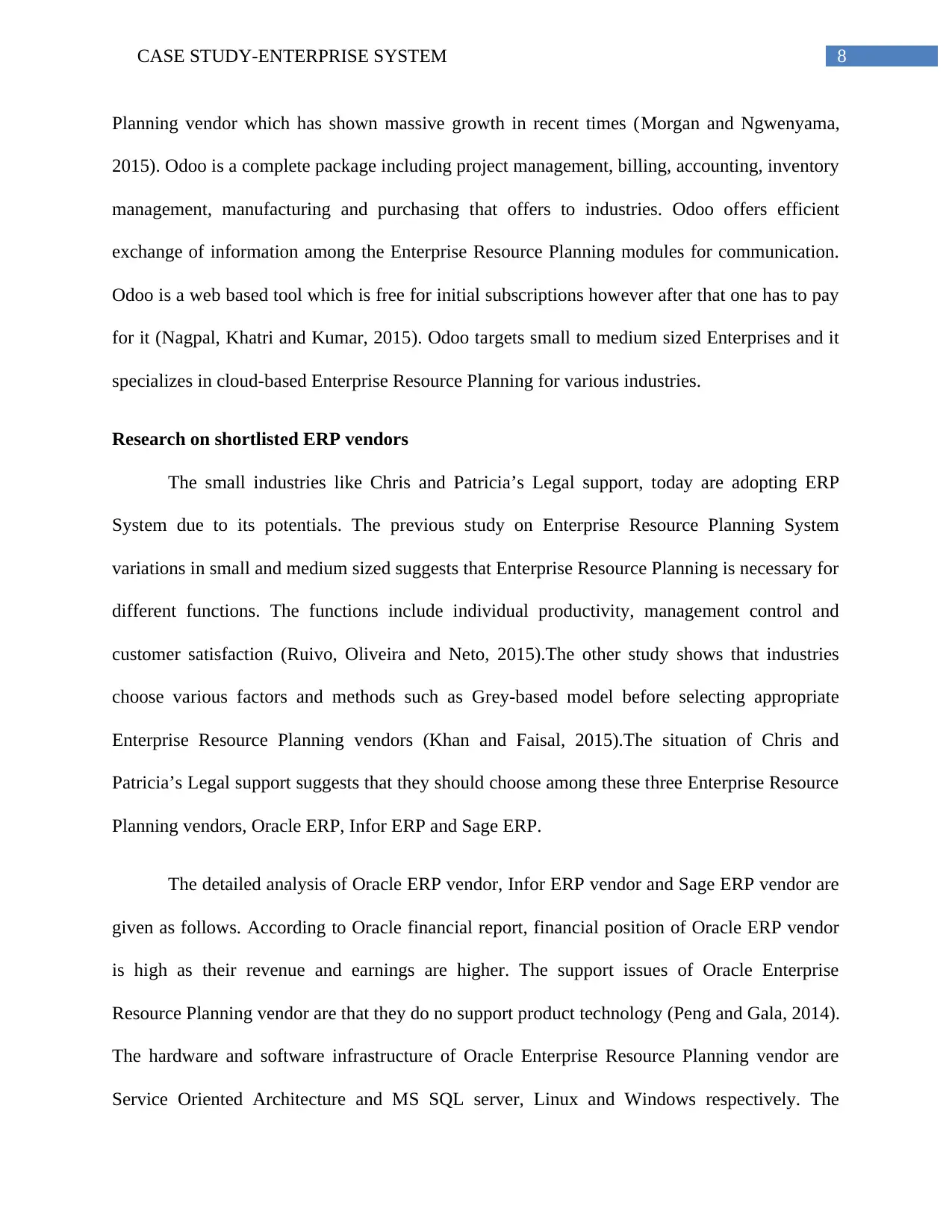
8CASE STUDY-ENTERPRISE SYSTEM
Planning vendor which has shown massive growth in recent times (Morgan and Ngwenyama,
2015). Odoo is a complete package including project management, billing, accounting, inventory
management, manufacturing and purchasing that offers to industries. Odoo offers efficient
exchange of information among the Enterprise Resource Planning modules for communication.
Odoo is a web based tool which is free for initial subscriptions however after that one has to pay
for it (Nagpal, Khatri and Kumar, 2015). Odoo targets small to medium sized Enterprises and it
specializes in cloud-based Enterprise Resource Planning for various industries.
Research on shortlisted ERP vendors
The small industries like Chris and Patricia’s Legal support, today are adopting ERP
System due to its potentials. The previous study on Enterprise Resource Planning System
variations in small and medium sized suggests that Enterprise Resource Planning is necessary for
different functions. The functions include individual productivity, management control and
customer satisfaction (Ruivo, Oliveira and Neto, 2015).The other study shows that industries
choose various factors and methods such as Grey-based model before selecting appropriate
Enterprise Resource Planning vendors (Khan and Faisal, 2015).The situation of Chris and
Patricia’s Legal support suggests that they should choose among these three Enterprise Resource
Planning vendors, Oracle ERP, Infor ERP and Sage ERP.
The detailed analysis of Oracle ERP vendor, Infor ERP vendor and Sage ERP vendor are
given as follows. According to Oracle financial report, financial position of Oracle ERP vendor
is high as their revenue and earnings are higher. The support issues of Oracle Enterprise
Resource Planning vendor are that they do no support product technology (Peng and Gala, 2014).
The hardware and software infrastructure of Oracle Enterprise Resource Planning vendor are
Service Oriented Architecture and MS SQL server, Linux and Windows respectively. The
Planning vendor which has shown massive growth in recent times (Morgan and Ngwenyama,
2015). Odoo is a complete package including project management, billing, accounting, inventory
management, manufacturing and purchasing that offers to industries. Odoo offers efficient
exchange of information among the Enterprise Resource Planning modules for communication.
Odoo is a web based tool which is free for initial subscriptions however after that one has to pay
for it (Nagpal, Khatri and Kumar, 2015). Odoo targets small to medium sized Enterprises and it
specializes in cloud-based Enterprise Resource Planning for various industries.
Research on shortlisted ERP vendors
The small industries like Chris and Patricia’s Legal support, today are adopting ERP
System due to its potentials. The previous study on Enterprise Resource Planning System
variations in small and medium sized suggests that Enterprise Resource Planning is necessary for
different functions. The functions include individual productivity, management control and
customer satisfaction (Ruivo, Oliveira and Neto, 2015).The other study shows that industries
choose various factors and methods such as Grey-based model before selecting appropriate
Enterprise Resource Planning vendors (Khan and Faisal, 2015).The situation of Chris and
Patricia’s Legal support suggests that they should choose among these three Enterprise Resource
Planning vendors, Oracle ERP, Infor ERP and Sage ERP.
The detailed analysis of Oracle ERP vendor, Infor ERP vendor and Sage ERP vendor are
given as follows. According to Oracle financial report, financial position of Oracle ERP vendor
is high as their revenue and earnings are higher. The support issues of Oracle Enterprise
Resource Planning vendor are that they do no support product technology (Peng and Gala, 2014).
The hardware and software infrastructure of Oracle Enterprise Resource Planning vendor are
Service Oriented Architecture and MS SQL server, Linux and Windows respectively. The
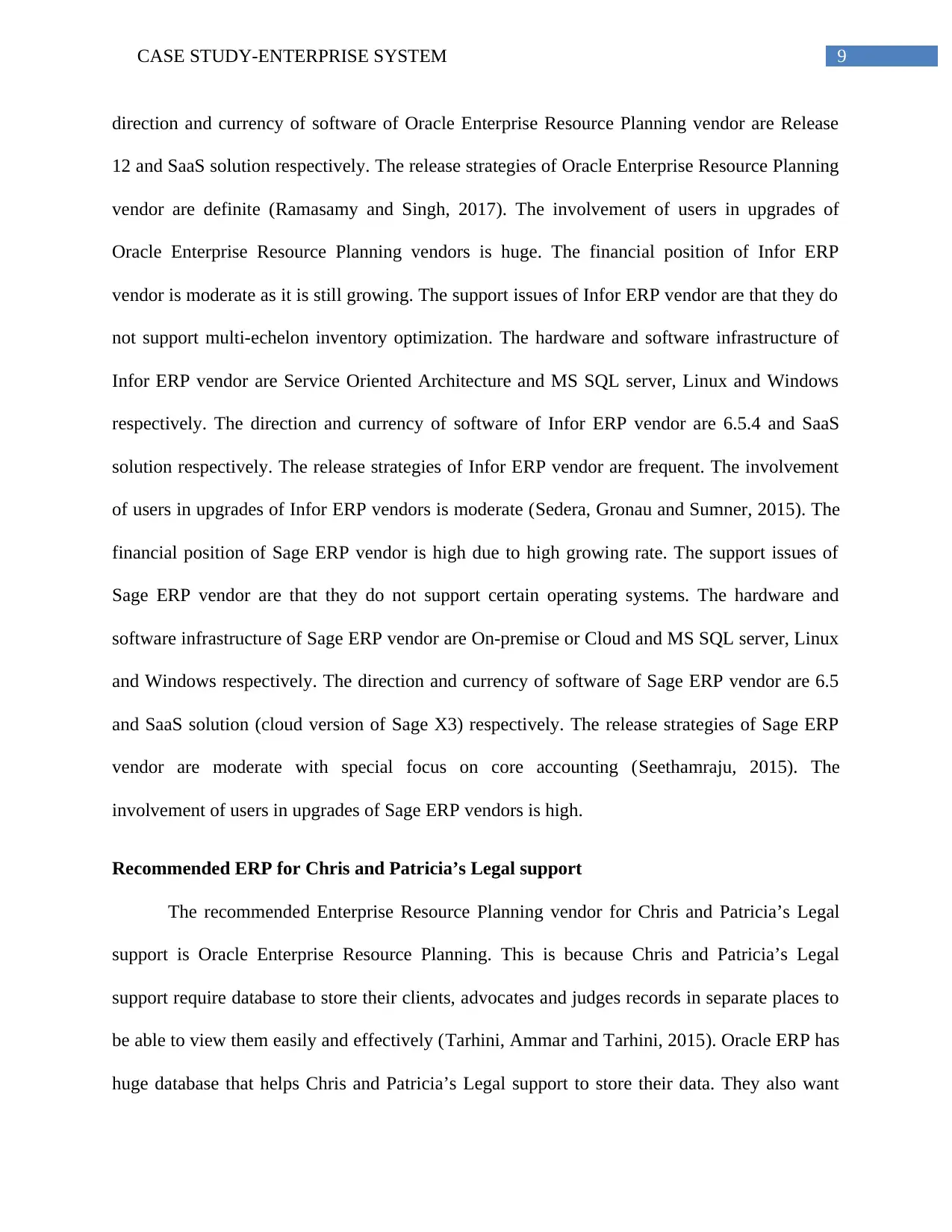
9CASE STUDY-ENTERPRISE SYSTEM
direction and currency of software of Oracle Enterprise Resource Planning vendor are Release
12 and SaaS solution respectively. The release strategies of Oracle Enterprise Resource Planning
vendor are definite (Ramasamy and Singh, 2017). The involvement of users in upgrades of
Oracle Enterprise Resource Planning vendors is huge. The financial position of Infor ERP
vendor is moderate as it is still growing. The support issues of Infor ERP vendor are that they do
not support multi-echelon inventory optimization. The hardware and software infrastructure of
Infor ERP vendor are Service Oriented Architecture and MS SQL server, Linux and Windows
respectively. The direction and currency of software of Infor ERP vendor are 6.5.4 and SaaS
solution respectively. The release strategies of Infor ERP vendor are frequent. The involvement
of users in upgrades of Infor ERP vendors is moderate (Sedera, Gronau and Sumner, 2015). The
financial position of Sage ERP vendor is high due to high growing rate. The support issues of
Sage ERP vendor are that they do not support certain operating systems. The hardware and
software infrastructure of Sage ERP vendor are On-premise or Cloud and MS SQL server, Linux
and Windows respectively. The direction and currency of software of Sage ERP vendor are 6.5
and SaaS solution (cloud version of Sage X3) respectively. The release strategies of Sage ERP
vendor are moderate with special focus on core accounting (Seethamraju, 2015). The
involvement of users in upgrades of Sage ERP vendors is high.
Recommended ERP for Chris and Patricia’s Legal support
The recommended Enterprise Resource Planning vendor for Chris and Patricia’s Legal
support is Oracle Enterprise Resource Planning. This is because Chris and Patricia’s Legal
support require database to store their clients, advocates and judges records in separate places to
be able to view them easily and effectively (Tarhini, Ammar and Tarhini, 2015). Oracle ERP has
huge database that helps Chris and Patricia’s Legal support to store their data. They also want
direction and currency of software of Oracle Enterprise Resource Planning vendor are Release
12 and SaaS solution respectively. The release strategies of Oracle Enterprise Resource Planning
vendor are definite (Ramasamy and Singh, 2017). The involvement of users in upgrades of
Oracle Enterprise Resource Planning vendors is huge. The financial position of Infor ERP
vendor is moderate as it is still growing. The support issues of Infor ERP vendor are that they do
not support multi-echelon inventory optimization. The hardware and software infrastructure of
Infor ERP vendor are Service Oriented Architecture and MS SQL server, Linux and Windows
respectively. The direction and currency of software of Infor ERP vendor are 6.5.4 and SaaS
solution respectively. The release strategies of Infor ERP vendor are frequent. The involvement
of users in upgrades of Infor ERP vendors is moderate (Sedera, Gronau and Sumner, 2015). The
financial position of Sage ERP vendor is high due to high growing rate. The support issues of
Sage ERP vendor are that they do not support certain operating systems. The hardware and
software infrastructure of Sage ERP vendor are On-premise or Cloud and MS SQL server, Linux
and Windows respectively. The direction and currency of software of Sage ERP vendor are 6.5
and SaaS solution (cloud version of Sage X3) respectively. The release strategies of Sage ERP
vendor are moderate with special focus on core accounting (Seethamraju, 2015). The
involvement of users in upgrades of Sage ERP vendors is high.
Recommended ERP for Chris and Patricia’s Legal support
The recommended Enterprise Resource Planning vendor for Chris and Patricia’s Legal
support is Oracle Enterprise Resource Planning. This is because Chris and Patricia’s Legal
support require database to store their clients, advocates and judges records in separate places to
be able to view them easily and effectively (Tarhini, Ammar and Tarhini, 2015). Oracle ERP has
huge database that helps Chris and Patricia’s Legal support to store their data. They also want
Secure Best Marks with AI Grader
Need help grading? Try our AI Grader for instant feedback on your assignments.
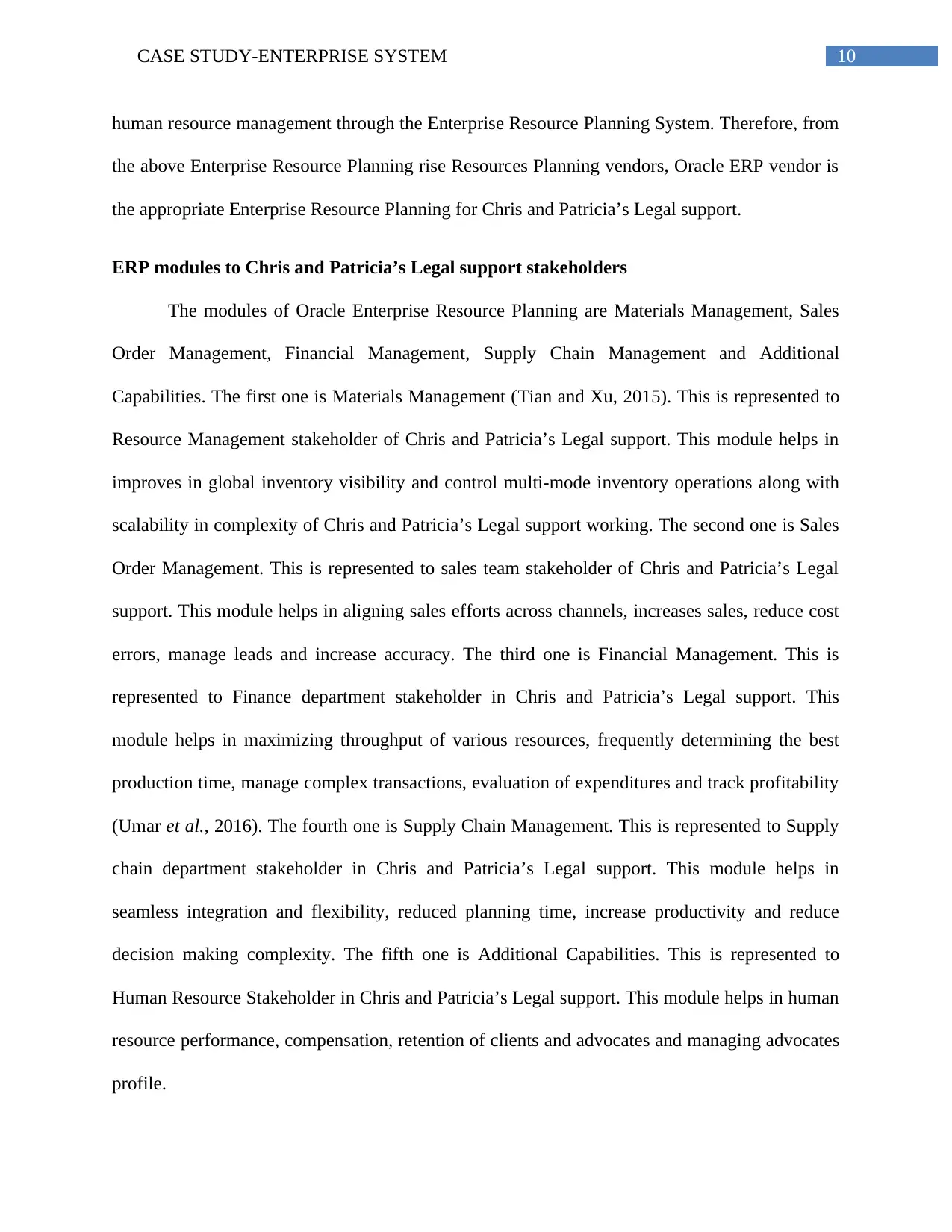
10CASE STUDY-ENTERPRISE SYSTEM
human resource management through the Enterprise Resource Planning System. Therefore, from
the above Enterprise Resource Planning rise Resources Planning vendors, Oracle ERP vendor is
the appropriate Enterprise Resource Planning for Chris and Patricia’s Legal support.
ERP modules to Chris and Patricia’s Legal support stakeholders
The modules of Oracle Enterprise Resource Planning are Materials Management, Sales
Order Management, Financial Management, Supply Chain Management and Additional
Capabilities. The first one is Materials Management (Tian and Xu, 2015). This is represented to
Resource Management stakeholder of Chris and Patricia’s Legal support. This module helps in
improves in global inventory visibility and control multi-mode inventory operations along with
scalability in complexity of Chris and Patricia’s Legal support working. The second one is Sales
Order Management. This is represented to sales team stakeholder of Chris and Patricia’s Legal
support. This module helps in aligning sales efforts across channels, increases sales, reduce cost
errors, manage leads and increase accuracy. The third one is Financial Management. This is
represented to Finance department stakeholder in Chris and Patricia’s Legal support. This
module helps in maximizing throughput of various resources, frequently determining the best
production time, manage complex transactions, evaluation of expenditures and track profitability
(Umar et al., 2016). The fourth one is Supply Chain Management. This is represented to Supply
chain department stakeholder in Chris and Patricia’s Legal support. This module helps in
seamless integration and flexibility, reduced planning time, increase productivity and reduce
decision making complexity. The fifth one is Additional Capabilities. This is represented to
Human Resource Stakeholder in Chris and Patricia’s Legal support. This module helps in human
resource performance, compensation, retention of clients and advocates and managing advocates
profile.
human resource management through the Enterprise Resource Planning System. Therefore, from
the above Enterprise Resource Planning rise Resources Planning vendors, Oracle ERP vendor is
the appropriate Enterprise Resource Planning for Chris and Patricia’s Legal support.
ERP modules to Chris and Patricia’s Legal support stakeholders
The modules of Oracle Enterprise Resource Planning are Materials Management, Sales
Order Management, Financial Management, Supply Chain Management and Additional
Capabilities. The first one is Materials Management (Tian and Xu, 2015). This is represented to
Resource Management stakeholder of Chris and Patricia’s Legal support. This module helps in
improves in global inventory visibility and control multi-mode inventory operations along with
scalability in complexity of Chris and Patricia’s Legal support working. The second one is Sales
Order Management. This is represented to sales team stakeholder of Chris and Patricia’s Legal
support. This module helps in aligning sales efforts across channels, increases sales, reduce cost
errors, manage leads and increase accuracy. The third one is Financial Management. This is
represented to Finance department stakeholder in Chris and Patricia’s Legal support. This
module helps in maximizing throughput of various resources, frequently determining the best
production time, manage complex transactions, evaluation of expenditures and track profitability
(Umar et al., 2016). The fourth one is Supply Chain Management. This is represented to Supply
chain department stakeholder in Chris and Patricia’s Legal support. This module helps in
seamless integration and flexibility, reduced planning time, increase productivity and reduce
decision making complexity. The fifth one is Additional Capabilities. This is represented to
Human Resource Stakeholder in Chris and Patricia’s Legal support. This module helps in human
resource performance, compensation, retention of clients and advocates and managing advocates
profile.
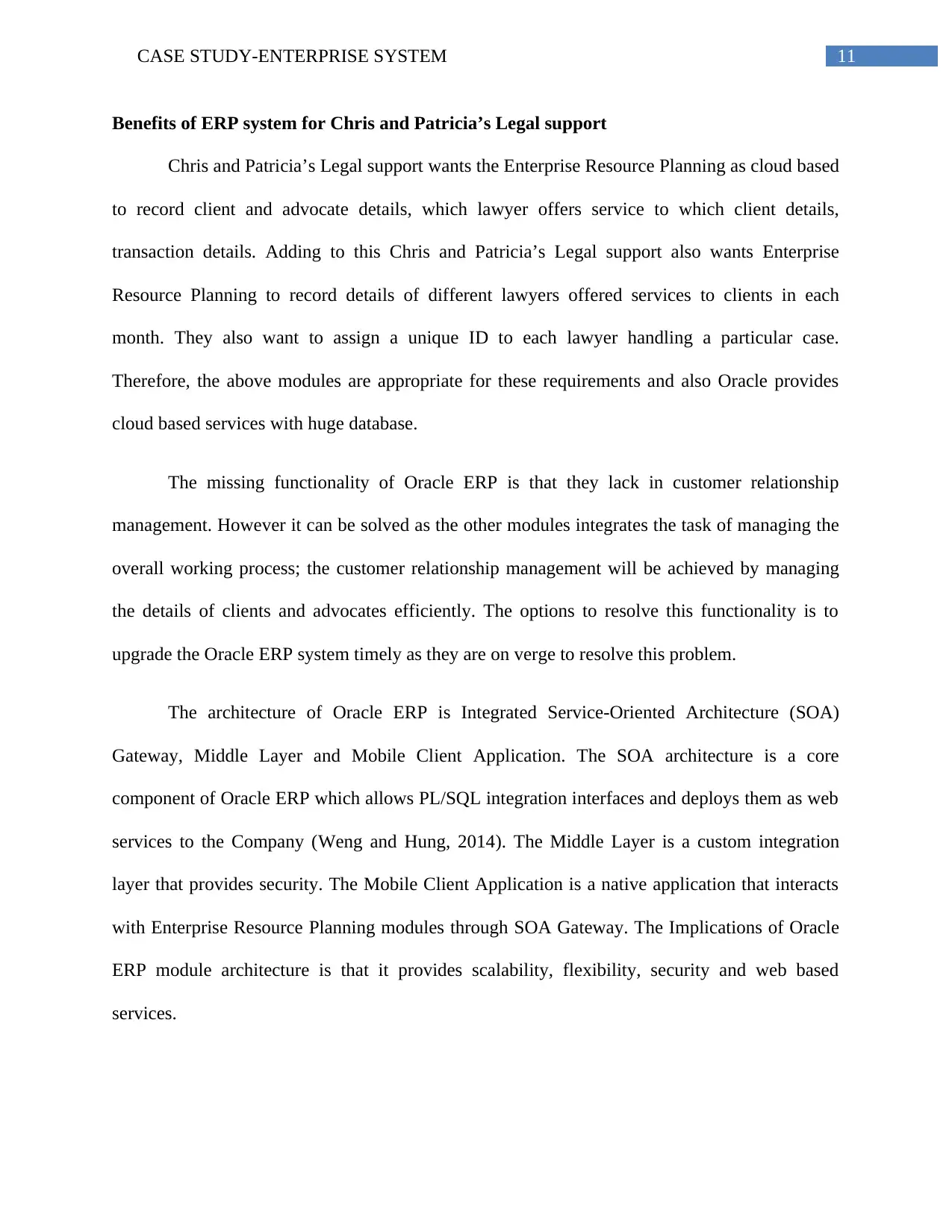
11CASE STUDY-ENTERPRISE SYSTEM
Benefits of ERP system for Chris and Patricia’s Legal support
Chris and Patricia’s Legal support wants the Enterprise Resource Planning as cloud based
to record client and advocate details, which lawyer offers service to which client details,
transaction details. Adding to this Chris and Patricia’s Legal support also wants Enterprise
Resource Planning to record details of different lawyers offered services to clients in each
month. They also want to assign a unique ID to each lawyer handling a particular case.
Therefore, the above modules are appropriate for these requirements and also Oracle provides
cloud based services with huge database.
The missing functionality of Oracle ERP is that they lack in customer relationship
management. However it can be solved as the other modules integrates the task of managing the
overall working process; the customer relationship management will be achieved by managing
the details of clients and advocates efficiently. The options to resolve this functionality is to
upgrade the Oracle ERP system timely as they are on verge to resolve this problem.
The architecture of Oracle ERP is Integrated Service-Oriented Architecture (SOA)
Gateway, Middle Layer and Mobile Client Application. The SOA architecture is a core
component of Oracle ERP which allows PL/SQL integration interfaces and deploys them as web
services to the Company (Weng and Hung, 2014). The Middle Layer is a custom integration
layer that provides security. The Mobile Client Application is a native application that interacts
with Enterprise Resource Planning modules through SOA Gateway. The Implications of Oracle
ERP module architecture is that it provides scalability, flexibility, security and web based
services.
Benefits of ERP system for Chris and Patricia’s Legal support
Chris and Patricia’s Legal support wants the Enterprise Resource Planning as cloud based
to record client and advocate details, which lawyer offers service to which client details,
transaction details. Adding to this Chris and Patricia’s Legal support also wants Enterprise
Resource Planning to record details of different lawyers offered services to clients in each
month. They also want to assign a unique ID to each lawyer handling a particular case.
Therefore, the above modules are appropriate for these requirements and also Oracle provides
cloud based services with huge database.
The missing functionality of Oracle ERP is that they lack in customer relationship
management. However it can be solved as the other modules integrates the task of managing the
overall working process; the customer relationship management will be achieved by managing
the details of clients and advocates efficiently. The options to resolve this functionality is to
upgrade the Oracle ERP system timely as they are on verge to resolve this problem.
The architecture of Oracle ERP is Integrated Service-Oriented Architecture (SOA)
Gateway, Middle Layer and Mobile Client Application. The SOA architecture is a core
component of Oracle ERP which allows PL/SQL integration interfaces and deploys them as web
services to the Company (Weng and Hung, 2014). The Middle Layer is a custom integration
layer that provides security. The Mobile Client Application is a native application that interacts
with Enterprise Resource Planning modules through SOA Gateway. The Implications of Oracle
ERP module architecture is that it provides scalability, flexibility, security and web based
services.
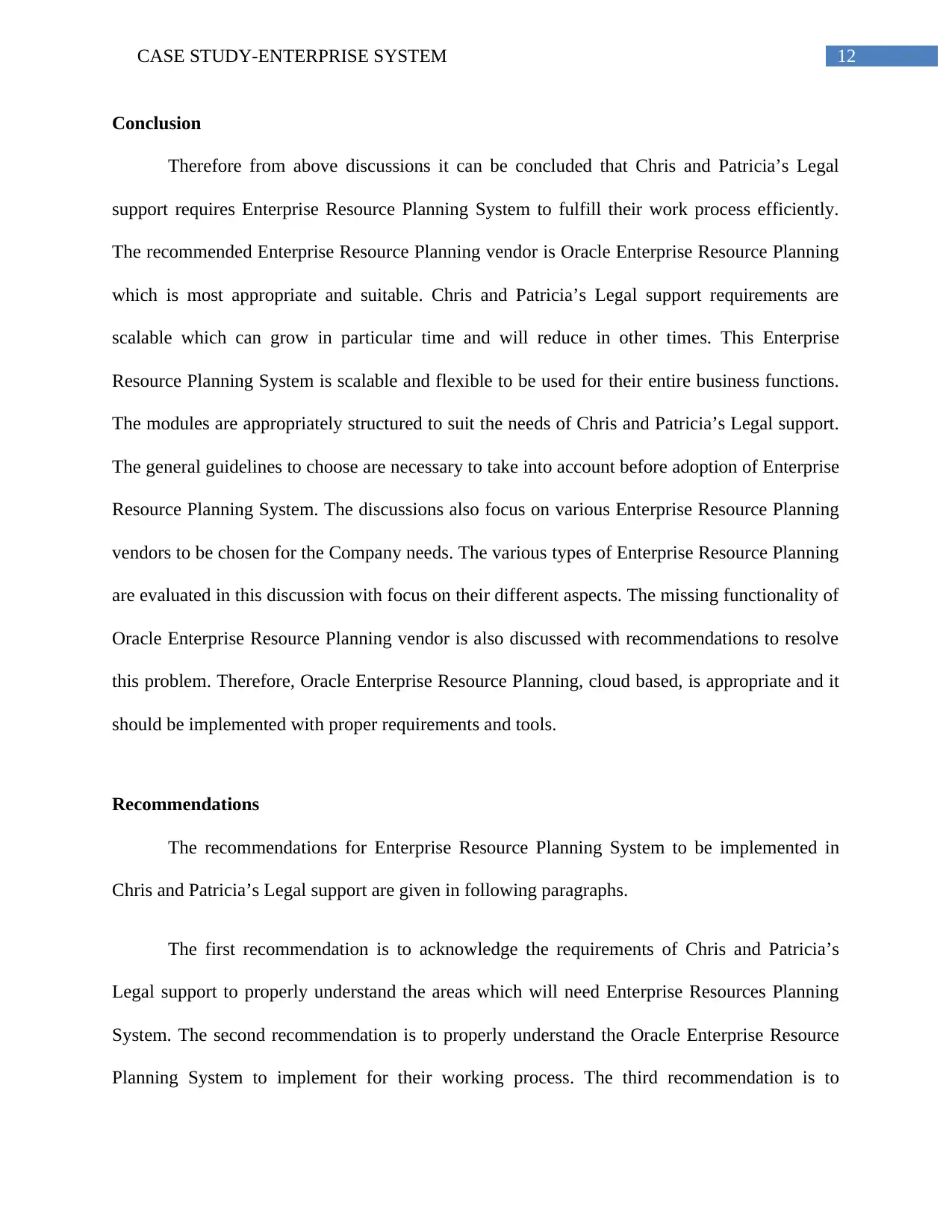
12CASE STUDY-ENTERPRISE SYSTEM
Conclusion
Therefore from above discussions it can be concluded that Chris and Patricia’s Legal
support requires Enterprise Resource Planning System to fulfill their work process efficiently.
The recommended Enterprise Resource Planning vendor is Oracle Enterprise Resource Planning
which is most appropriate and suitable. Chris and Patricia’s Legal support requirements are
scalable which can grow in particular time and will reduce in other times. This Enterprise
Resource Planning System is scalable and flexible to be used for their entire business functions.
The modules are appropriately structured to suit the needs of Chris and Patricia’s Legal support.
The general guidelines to choose are necessary to take into account before adoption of Enterprise
Resource Planning System. The discussions also focus on various Enterprise Resource Planning
vendors to be chosen for the Company needs. The various types of Enterprise Resource Planning
are evaluated in this discussion with focus on their different aspects. The missing functionality of
Oracle Enterprise Resource Planning vendor is also discussed with recommendations to resolve
this problem. Therefore, Oracle Enterprise Resource Planning, cloud based, is appropriate and it
should be implemented with proper requirements and tools.
Recommendations
The recommendations for Enterprise Resource Planning System to be implemented in
Chris and Patricia’s Legal support are given in following paragraphs.
The first recommendation is to acknowledge the requirements of Chris and Patricia’s
Legal support to properly understand the areas which will need Enterprise Resources Planning
System. The second recommendation is to properly understand the Oracle Enterprise Resource
Planning System to implement for their working process. The third recommendation is to
Conclusion
Therefore from above discussions it can be concluded that Chris and Patricia’s Legal
support requires Enterprise Resource Planning System to fulfill their work process efficiently.
The recommended Enterprise Resource Planning vendor is Oracle Enterprise Resource Planning
which is most appropriate and suitable. Chris and Patricia’s Legal support requirements are
scalable which can grow in particular time and will reduce in other times. This Enterprise
Resource Planning System is scalable and flexible to be used for their entire business functions.
The modules are appropriately structured to suit the needs of Chris and Patricia’s Legal support.
The general guidelines to choose are necessary to take into account before adoption of Enterprise
Resource Planning System. The discussions also focus on various Enterprise Resource Planning
vendors to be chosen for the Company needs. The various types of Enterprise Resource Planning
are evaluated in this discussion with focus on their different aspects. The missing functionality of
Oracle Enterprise Resource Planning vendor is also discussed with recommendations to resolve
this problem. Therefore, Oracle Enterprise Resource Planning, cloud based, is appropriate and it
should be implemented with proper requirements and tools.
Recommendations
The recommendations for Enterprise Resource Planning System to be implemented in
Chris and Patricia’s Legal support are given in following paragraphs.
The first recommendation is to acknowledge the requirements of Chris and Patricia’s
Legal support to properly understand the areas which will need Enterprise Resources Planning
System. The second recommendation is to properly understand the Oracle Enterprise Resource
Planning System to implement for their working process. The third recommendation is to
Paraphrase This Document
Need a fresh take? Get an instant paraphrase of this document with our AI Paraphraser
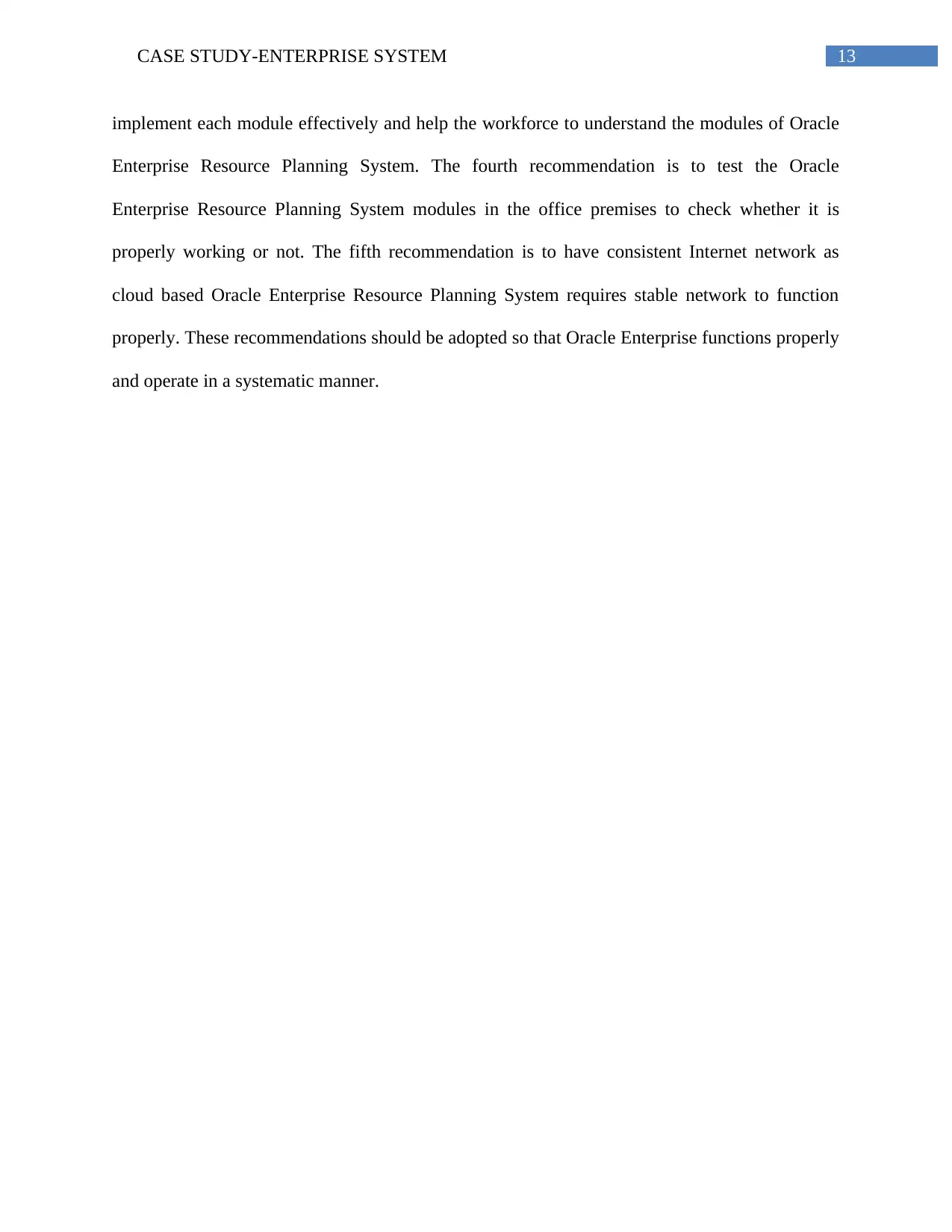
13CASE STUDY-ENTERPRISE SYSTEM
implement each module effectively and help the workforce to understand the modules of Oracle
Enterprise Resource Planning System. The fourth recommendation is to test the Oracle
Enterprise Resource Planning System modules in the office premises to check whether it is
properly working or not. The fifth recommendation is to have consistent Internet network as
cloud based Oracle Enterprise Resource Planning System requires stable network to function
properly. These recommendations should be adopted so that Oracle Enterprise functions properly
and operate in a systematic manner.
implement each module effectively and help the workforce to understand the modules of Oracle
Enterprise Resource Planning System. The fourth recommendation is to test the Oracle
Enterprise Resource Planning System modules in the office premises to check whether it is
properly working or not. The fifth recommendation is to have consistent Internet network as
cloud based Oracle Enterprise Resource Planning System requires stable network to function
properly. These recommendations should be adopted so that Oracle Enterprise functions properly
and operate in a systematic manner.
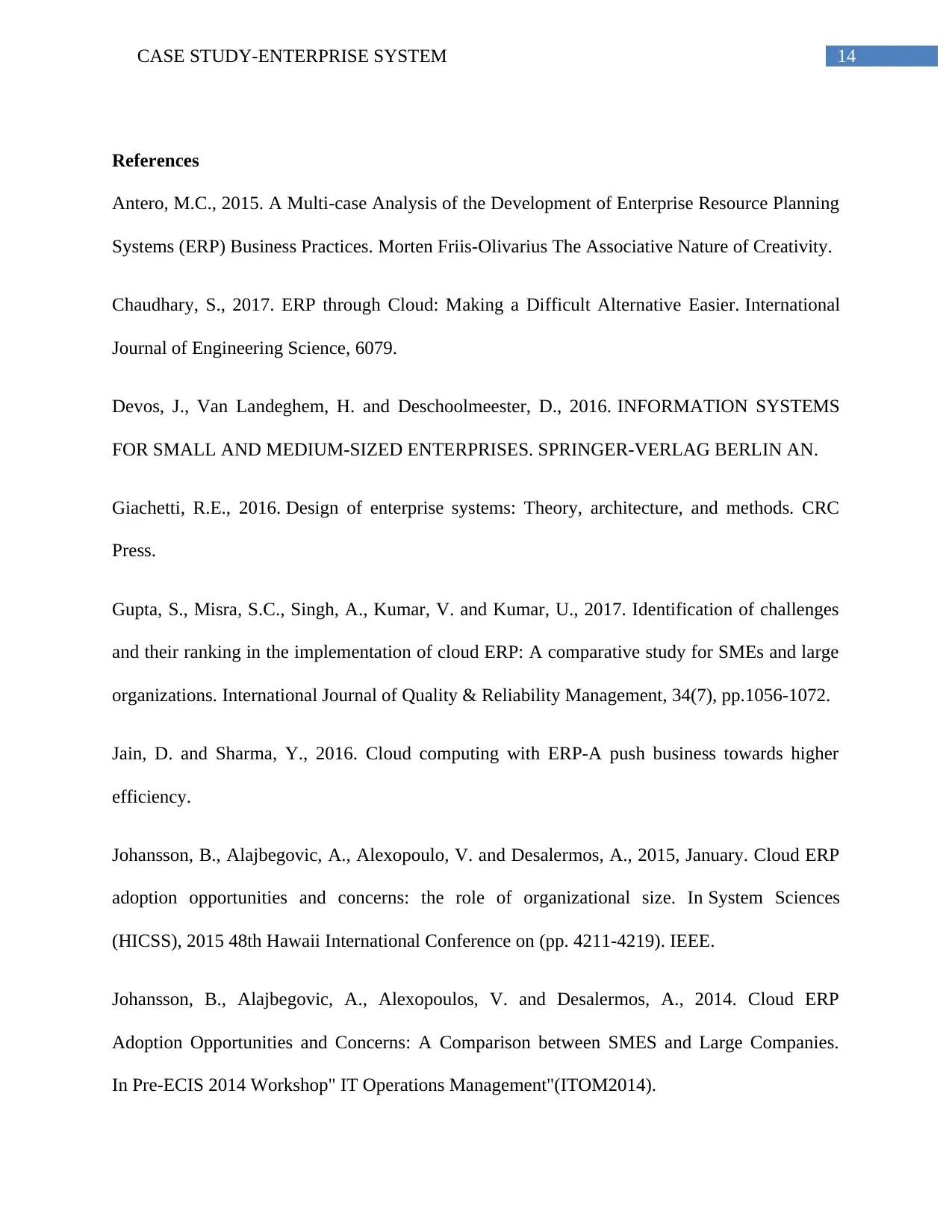
14CASE STUDY-ENTERPRISE SYSTEM
References
Antero, M.C., 2015. A Multi-case Analysis of the Development of Enterprise Resource Planning
Systems (ERP) Business Practices. Morten Friis-Olivarius The Associative Nature of Creativity.
Chaudhary, S., 2017. ERP through Cloud: Making a Difficult Alternative Easier. International
Journal of Engineering Science, 6079.
Devos, J., Van Landeghem, H. and Deschoolmeester, D., 2016. INFORMATION SYSTEMS
FOR SMALL AND MEDIUM-SIZED ENTERPRISES. SPRINGER-VERLAG BERLIN AN.
Giachetti, R.E., 2016. Design of enterprise systems: Theory, architecture, and methods. CRC
Press.
Gupta, S., Misra, S.C., Singh, A., Kumar, V. and Kumar, U., 2017. Identification of challenges
and their ranking in the implementation of cloud ERP: A comparative study for SMEs and large
organizations. International Journal of Quality & Reliability Management, 34(7), pp.1056-1072.
Jain, D. and Sharma, Y., 2016. Cloud computing with ERP-A push business towards higher
efficiency.
Johansson, B., Alajbegovic, A., Alexopoulo, V. and Desalermos, A., 2015, January. Cloud ERP
adoption opportunities and concerns: the role of organizational size. In System Sciences
(HICSS), 2015 48th Hawaii International Conference on (pp. 4211-4219). IEEE.
Johansson, B., Alajbegovic, A., Alexopoulos, V. and Desalermos, A., 2014. Cloud ERP
Adoption Opportunities and Concerns: A Comparison between SMES and Large Companies.
In Pre-ECIS 2014 Workshop" IT Operations Management"(ITOM2014).
References
Antero, M.C., 2015. A Multi-case Analysis of the Development of Enterprise Resource Planning
Systems (ERP) Business Practices. Morten Friis-Olivarius The Associative Nature of Creativity.
Chaudhary, S., 2017. ERP through Cloud: Making a Difficult Alternative Easier. International
Journal of Engineering Science, 6079.
Devos, J., Van Landeghem, H. and Deschoolmeester, D., 2016. INFORMATION SYSTEMS
FOR SMALL AND MEDIUM-SIZED ENTERPRISES. SPRINGER-VERLAG BERLIN AN.
Giachetti, R.E., 2016. Design of enterprise systems: Theory, architecture, and methods. CRC
Press.
Gupta, S., Misra, S.C., Singh, A., Kumar, V. and Kumar, U., 2017. Identification of challenges
and their ranking in the implementation of cloud ERP: A comparative study for SMEs and large
organizations. International Journal of Quality & Reliability Management, 34(7), pp.1056-1072.
Jain, D. and Sharma, Y., 2016. Cloud computing with ERP-A push business towards higher
efficiency.
Johansson, B., Alajbegovic, A., Alexopoulo, V. and Desalermos, A., 2015, January. Cloud ERP
adoption opportunities and concerns: the role of organizational size. In System Sciences
(HICSS), 2015 48th Hawaii International Conference on (pp. 4211-4219). IEEE.
Johansson, B., Alajbegovic, A., Alexopoulos, V. and Desalermos, A., 2014. Cloud ERP
Adoption Opportunities and Concerns: A Comparison between SMES and Large Companies.
In Pre-ECIS 2014 Workshop" IT Operations Management"(ITOM2014).
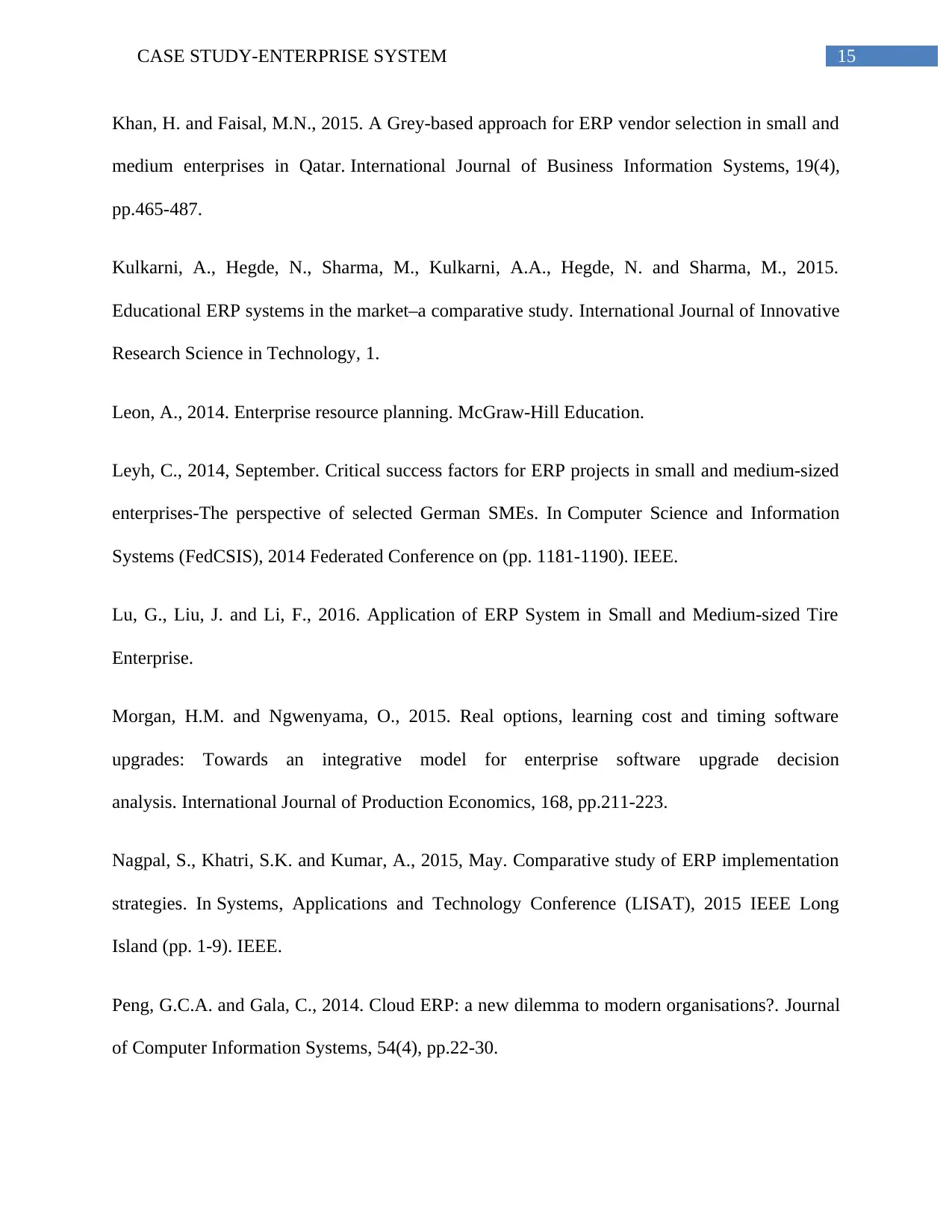
15CASE STUDY-ENTERPRISE SYSTEM
Khan, H. and Faisal, M.N., 2015. A Grey-based approach for ERP vendor selection in small and
medium enterprises in Qatar. International Journal of Business Information Systems, 19(4),
pp.465-487.
Kulkarni, A., Hegde, N., Sharma, M., Kulkarni, A.A., Hegde, N. and Sharma, M., 2015.
Educational ERP systems in the market–a comparative study. International Journal of Innovative
Research Science in Technology, 1.
Leon, A., 2014. Enterprise resource planning. McGraw-Hill Education.
Leyh, C., 2014, September. Critical success factors for ERP projects in small and medium-sized
enterprises-The perspective of selected German SMEs. In Computer Science and Information
Systems (FedCSIS), 2014 Federated Conference on (pp. 1181-1190). IEEE.
Lu, G., Liu, J. and Li, F., 2016. Application of ERP System in Small and Medium-sized Tire
Enterprise.
Morgan, H.M. and Ngwenyama, O., 2015. Real options, learning cost and timing software
upgrades: Towards an integrative model for enterprise software upgrade decision
analysis. International Journal of Production Economics, 168, pp.211-223.
Nagpal, S., Khatri, S.K. and Kumar, A., 2015, May. Comparative study of ERP implementation
strategies. In Systems, Applications and Technology Conference (LISAT), 2015 IEEE Long
Island (pp. 1-9). IEEE.
Peng, G.C.A. and Gala, C., 2014. Cloud ERP: a new dilemma to modern organisations?. Journal
of Computer Information Systems, 54(4), pp.22-30.
Khan, H. and Faisal, M.N., 2015. A Grey-based approach for ERP vendor selection in small and
medium enterprises in Qatar. International Journal of Business Information Systems, 19(4),
pp.465-487.
Kulkarni, A., Hegde, N., Sharma, M., Kulkarni, A.A., Hegde, N. and Sharma, M., 2015.
Educational ERP systems in the market–a comparative study. International Journal of Innovative
Research Science in Technology, 1.
Leon, A., 2014. Enterprise resource planning. McGraw-Hill Education.
Leyh, C., 2014, September. Critical success factors for ERP projects in small and medium-sized
enterprises-The perspective of selected German SMEs. In Computer Science and Information
Systems (FedCSIS), 2014 Federated Conference on (pp. 1181-1190). IEEE.
Lu, G., Liu, J. and Li, F., 2016. Application of ERP System in Small and Medium-sized Tire
Enterprise.
Morgan, H.M. and Ngwenyama, O., 2015. Real options, learning cost and timing software
upgrades: Towards an integrative model for enterprise software upgrade decision
analysis. International Journal of Production Economics, 168, pp.211-223.
Nagpal, S., Khatri, S.K. and Kumar, A., 2015, May. Comparative study of ERP implementation
strategies. In Systems, Applications and Technology Conference (LISAT), 2015 IEEE Long
Island (pp. 1-9). IEEE.
Peng, G.C.A. and Gala, C., 2014. Cloud ERP: a new dilemma to modern organisations?. Journal
of Computer Information Systems, 54(4), pp.22-30.
Secure Best Marks with AI Grader
Need help grading? Try our AI Grader for instant feedback on your assignments.
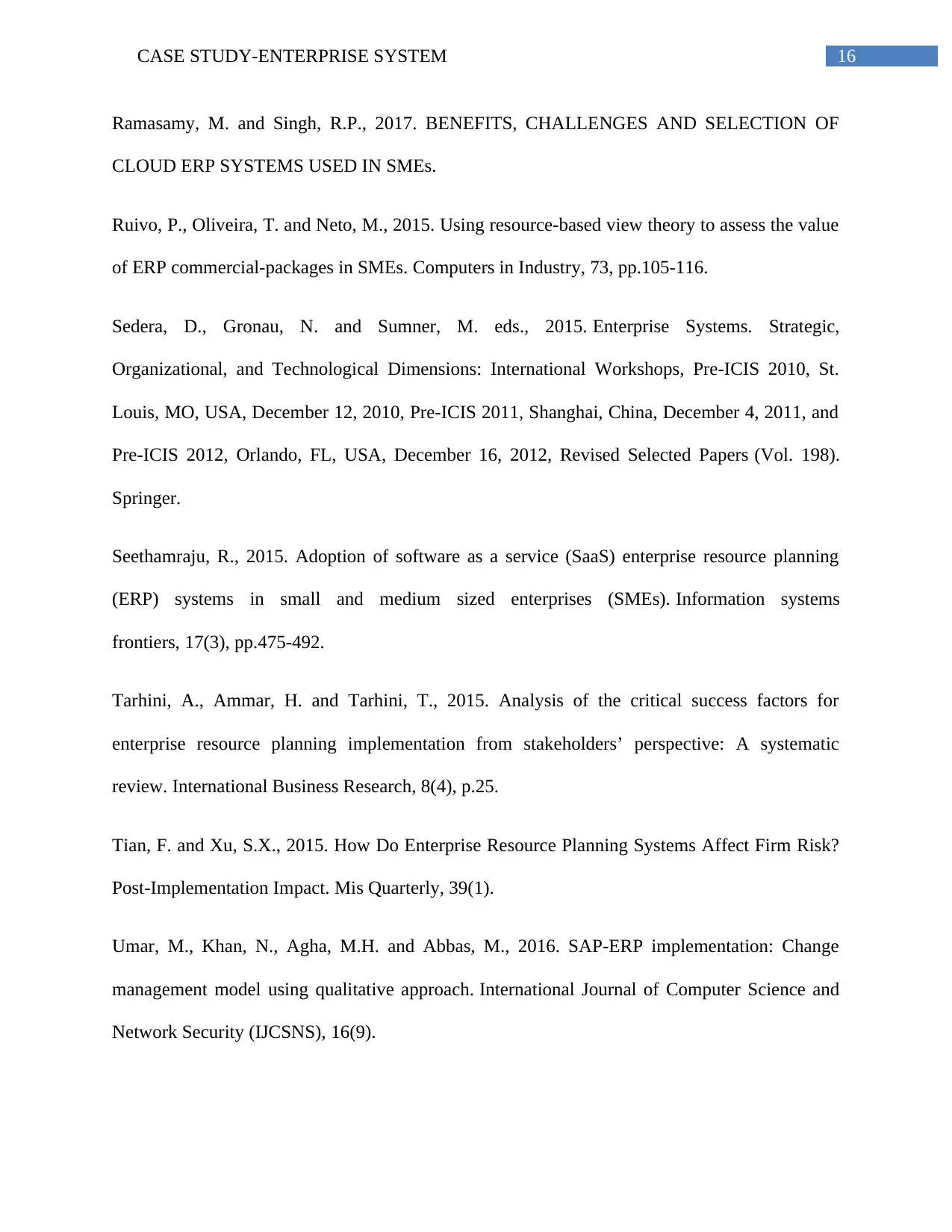
16CASE STUDY-ENTERPRISE SYSTEM
Ramasamy, M. and Singh, R.P., 2017. BENEFITS, CHALLENGES AND SELECTION OF
CLOUD ERP SYSTEMS USED IN SMEs.
Ruivo, P., Oliveira, T. and Neto, M., 2015. Using resource-based view theory to assess the value
of ERP commercial-packages in SMEs. Computers in Industry, 73, pp.105-116.
Sedera, D., Gronau, N. and Sumner, M. eds., 2015. Enterprise Systems. Strategic,
Organizational, and Technological Dimensions: International Workshops, Pre-ICIS 2010, St.
Louis, MO, USA, December 12, 2010, Pre-ICIS 2011, Shanghai, China, December 4, 2011, and
Pre-ICIS 2012, Orlando, FL, USA, December 16, 2012, Revised Selected Papers (Vol. 198).
Springer.
Seethamraju, R., 2015. Adoption of software as a service (SaaS) enterprise resource planning
(ERP) systems in small and medium sized enterprises (SMEs). Information systems
frontiers, 17(3), pp.475-492.
Tarhini, A., Ammar, H. and Tarhini, T., 2015. Analysis of the critical success factors for
enterprise resource planning implementation from stakeholders’ perspective: A systematic
review. International Business Research, 8(4), p.25.
Tian, F. and Xu, S.X., 2015. How Do Enterprise Resource Planning Systems Affect Firm Risk?
Post-Implementation Impact. Mis Quarterly, 39(1).
Umar, M., Khan, N., Agha, M.H. and Abbas, M., 2016. SAP-ERP implementation: Change
management model using qualitative approach. International Journal of Computer Science and
Network Security (IJCSNS), 16(9).
Ramasamy, M. and Singh, R.P., 2017. BENEFITS, CHALLENGES AND SELECTION OF
CLOUD ERP SYSTEMS USED IN SMEs.
Ruivo, P., Oliveira, T. and Neto, M., 2015. Using resource-based view theory to assess the value
of ERP commercial-packages in SMEs. Computers in Industry, 73, pp.105-116.
Sedera, D., Gronau, N. and Sumner, M. eds., 2015. Enterprise Systems. Strategic,
Organizational, and Technological Dimensions: International Workshops, Pre-ICIS 2010, St.
Louis, MO, USA, December 12, 2010, Pre-ICIS 2011, Shanghai, China, December 4, 2011, and
Pre-ICIS 2012, Orlando, FL, USA, December 16, 2012, Revised Selected Papers (Vol. 198).
Springer.
Seethamraju, R., 2015. Adoption of software as a service (SaaS) enterprise resource planning
(ERP) systems in small and medium sized enterprises (SMEs). Information systems
frontiers, 17(3), pp.475-492.
Tarhini, A., Ammar, H. and Tarhini, T., 2015. Analysis of the critical success factors for
enterprise resource planning implementation from stakeholders’ perspective: A systematic
review. International Business Research, 8(4), p.25.
Tian, F. and Xu, S.X., 2015. How Do Enterprise Resource Planning Systems Affect Firm Risk?
Post-Implementation Impact. Mis Quarterly, 39(1).
Umar, M., Khan, N., Agha, M.H. and Abbas, M., 2016. SAP-ERP implementation: Change
management model using qualitative approach. International Journal of Computer Science and
Network Security (IJCSNS), 16(9).
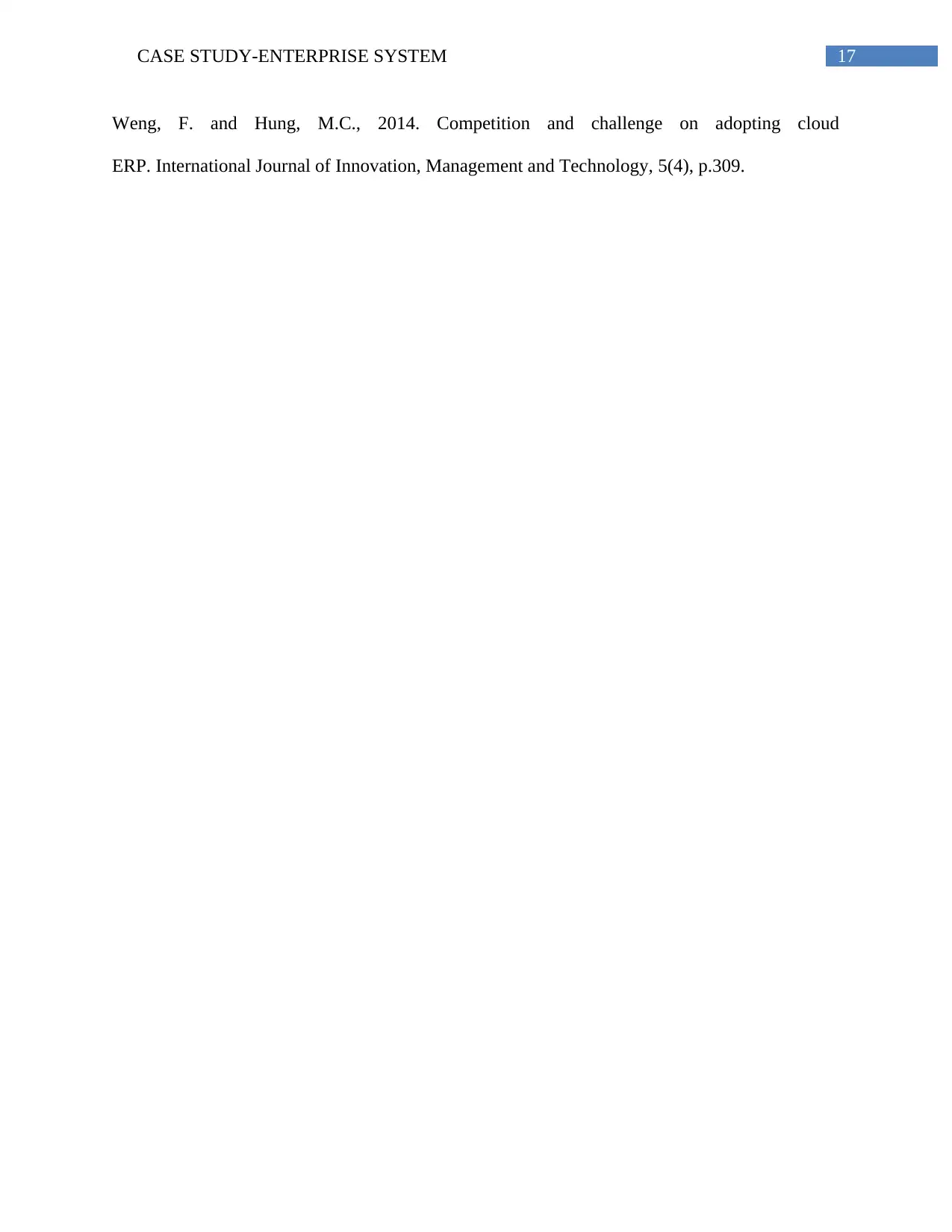
17CASE STUDY-ENTERPRISE SYSTEM
Weng, F. and Hung, M.C., 2014. Competition and challenge on adopting cloud
ERP. International Journal of Innovation, Management and Technology, 5(4), p.309.
Weng, F. and Hung, M.C., 2014. Competition and challenge on adopting cloud
ERP. International Journal of Innovation, Management and Technology, 5(4), p.309.
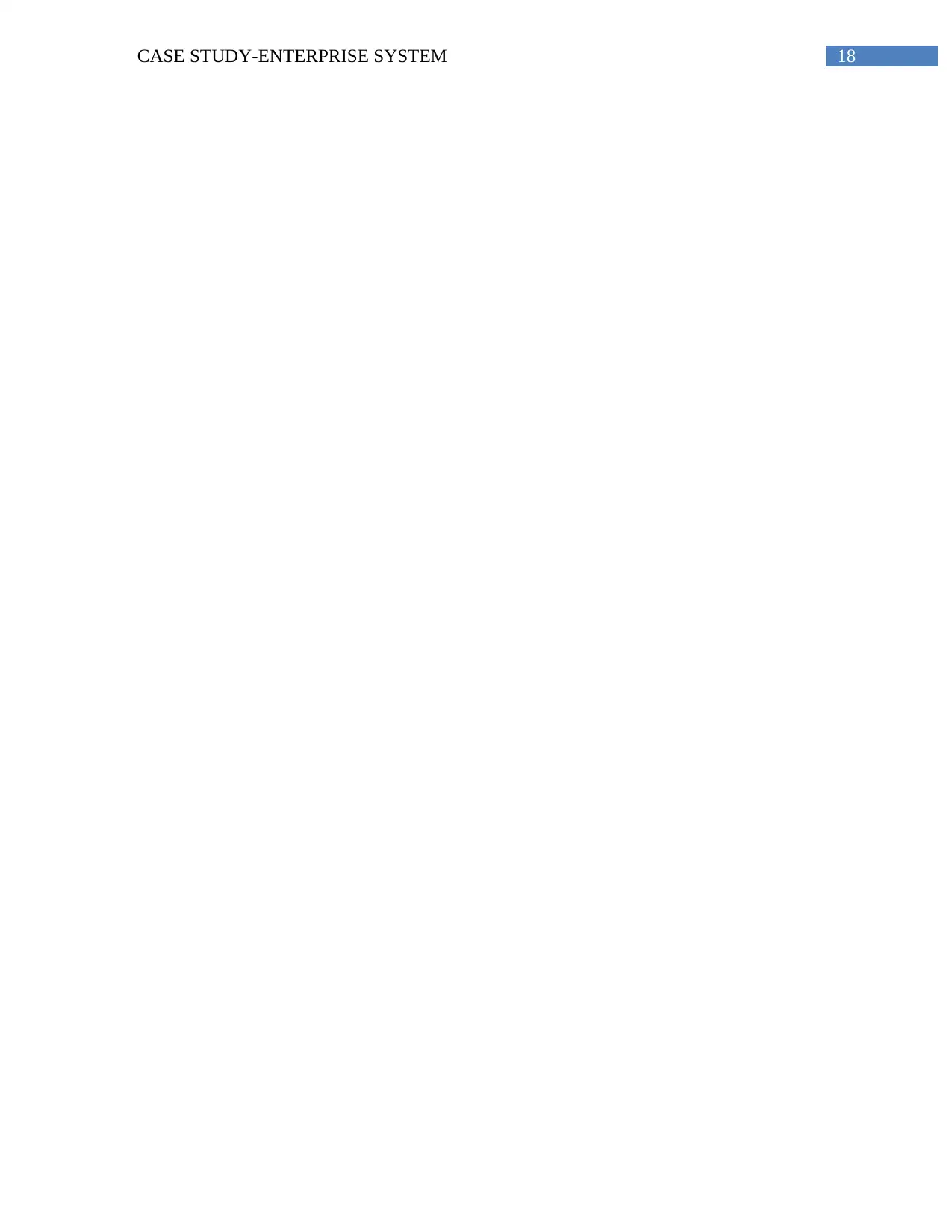
18CASE STUDY-ENTERPRISE SYSTEM
1 out of 19
Related Documents
Your All-in-One AI-Powered Toolkit for Academic Success.
+13062052269
info@desklib.com
Available 24*7 on WhatsApp / Email
![[object Object]](/_next/static/media/star-bottom.7253800d.svg)
Unlock your academic potential
© 2024 | Zucol Services PVT LTD | All rights reserved.




